
|
Elly Dekker |
Caspar Vopel's Ventures in Sixteenth-Century Celestial Cartography, 1532-1570 |

This paper concerns the
undertakings in celestial cartography of the sixteenth-century
Cet
article concerne les travaux en cartographie céleste du cartographe de
Cologne du XVIe siècle, Caspar Vopel. On
y décrit des exemplaires de son globe céleste imprimé ainsi que des cartes célestes figurées
sur sa mappemonde. La production de cartes célestes de Vopel montre son intérêt
singulier pour les mythes astronomiques à travers une série de caractéristiques
iconographiques remarquables. En particulier, l'introduction des constellations
d'Antinoüs et de la Chevelure de Bérénice (Coma Berenices en latin) se révèle
avoir été inspirée par une édition humaniste du catalogue des étoiles
de Ptolémée. Finalement, une étude des cartes célestes présentes sur les
copies de la mappemonde de Vopel par Valvassore (1558) et par Van den Putte
(1570) montre que ces copies reprennent différentes éditions de la carte
du monde de Vopel et que les cartes célestes présentes sur la mappemonde
de Matteo Pagano ont été copiées à leur tour à partir de celles de la
carte du monde de Valvassore.
Dieser Beitrag beschäftigt sich
mit der Himmelskartographie des Kölner Kartographen Caspar Vopel. Exemplare
seines gedruckten Himmelsglobus und der Himmelskarten, die sich auf seinen
Weltkarten befinden, werden beschrieben. Eine Reihe auffallender
ikonographischer Elemente auf Vopels Himmelskarten lassen sein außerordentliches
Interesse an astronomischen Mythen erkennen. Besonders seine Einführung der
Sternbilder Antinous und Coma Berenice wurden offensichtlich durch eine
humanistische Ausgabe des Sternkatalogs von Ptolemäus inspiriert. Darüber
hinaus zeigt die Untersuchung der Himmelskarten auf den Kopien nach Vopels
Weltkarte durch Valvassore (1558) und Van den Putte (1570), dass diese auf
unterschiedlichen Ausgaben von Vopels Weltkarte basieren und dass die
Himmelskarten auf der Weltkarte von Matteo Pagano von denen auf der Weltkarte
von Valvassore kopiert wurden.
Este artículo se centra en los proyectos de cartografía celeste del cartógrafo del siglo XVI Caspar Vopel, natural de Colonia. Se describen las copias impresas de su globo, y de los mapas celestes incluidos en su mapa del mundo. Los mapas celestes de Vopel muestran su extraordinario interés en los mitos astronómicos a través de una serie de llamativas imágenes. En particular la introducción de Vopel de las imágenes de Antinoo y Coma Berenice revela haber sido inspirada por una edición humanística del catálogo de estrellas de Ptolomeo. Por último, un estudio de los mapas celestes del mapa del mundo de Vopel, copiados por Valvassore (1558) y por Van den Putte (1570), muestra que esas copias son de diferentes ediciones del mapa del mundo de Vopel, y que los mapas celestes del mapa del mundo de Matteo Pagano fueron a su vez copiados de los del mapa del mundo de Valvassore.
Caspar Vopel (1511–1561) was born in Medebach, a small town not far from
In 1526 he entered the
Vopel became a well-known cartographer and was also active as an instrument
maker: (3)
Although his world map and his maps of Europe and the
This paper aims to fill in the gap
by describing Vopel's celestial globes and maps, with special attention given to
innovations introduced on their initations and derivatives.
In discussing Vopel's celestial cartography I follow existing conventions
and denote constellations by their Latin names. Subgroups, such as the Pleiades,
are referred to by their English names. Stars are identified in one of two ways:
by modern convention or by the serial number from its Ptolemaic constellation.
Thus Regulus, the brightest star in Leo, is denoted as α Leo or Leo 8.
Unformed stars of a constellation, listed by Ptolemy separately after the
‘formed’ stars because they are located outside the imaginary constellation
figure, are numbered as 1e, 2e and so on, with ‘e’ standing for external.
Thus the first of the unformed stars of Leo is Leo 1e, the second Leo 2e. (5)
The lasting merit of Vopel's printed globe and maps—or so it appears in retrospect—is the images of two star groups, Antinous and the Lock of Hair, better known as Coma Berenices, neither of which had previously been represented graphically. Their introduction on Vopel's printed globe of 1536 started a process by which the two groups came to be recognized as individual constellations. Since then, many other new constellation figures have been added to the celestial sky, sometimes for unformed stars in the northern hemisphere, at other times for stars newly recorded in the southern sky during voyages of exploration. The impact of Vopel's initiative raises a number of questions including why Vopel introduced the images of Antinous and Coma Berenices and what the reaction of his contemporaries was. Before dealing with these questions, however, we need to look at Vopel's various undertakings in celestial cartography.
https://www.kulturelles-erbe-koeln.de/documents/obj/05741337
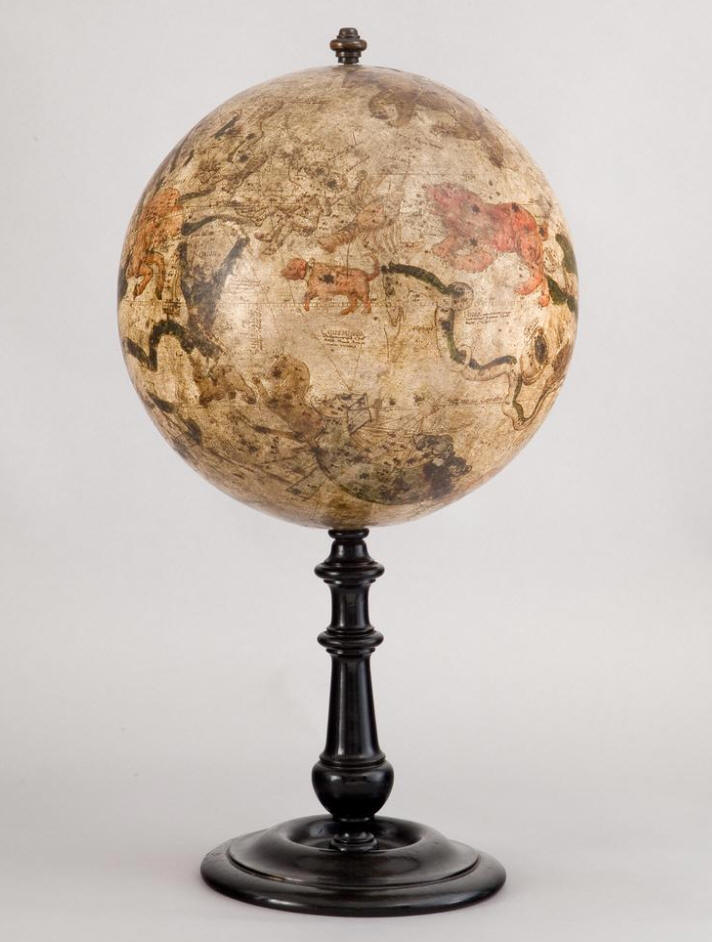
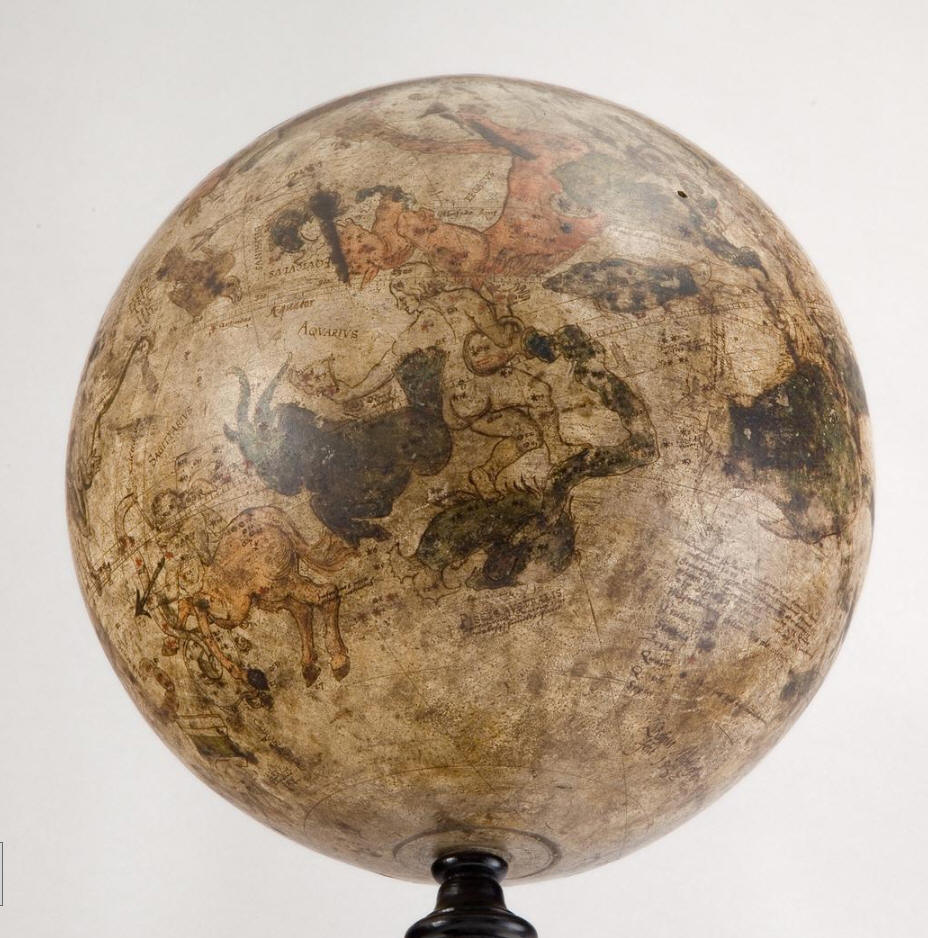
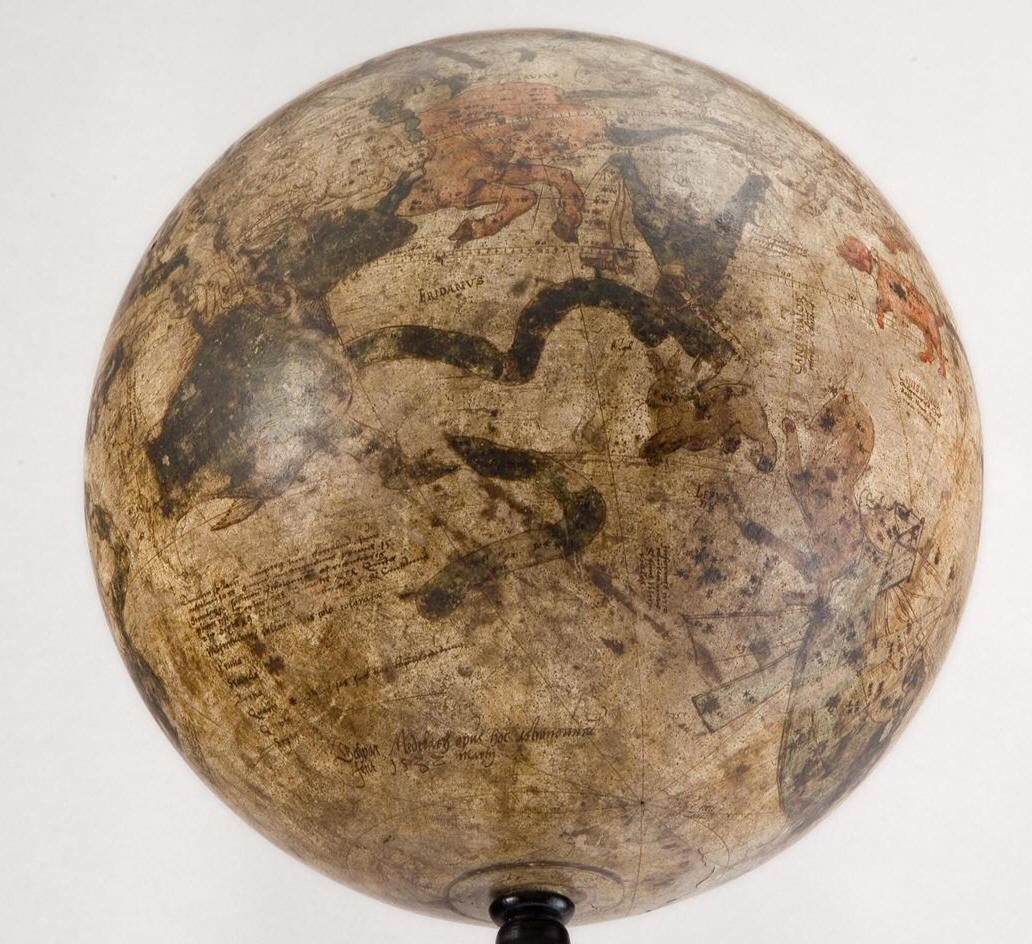
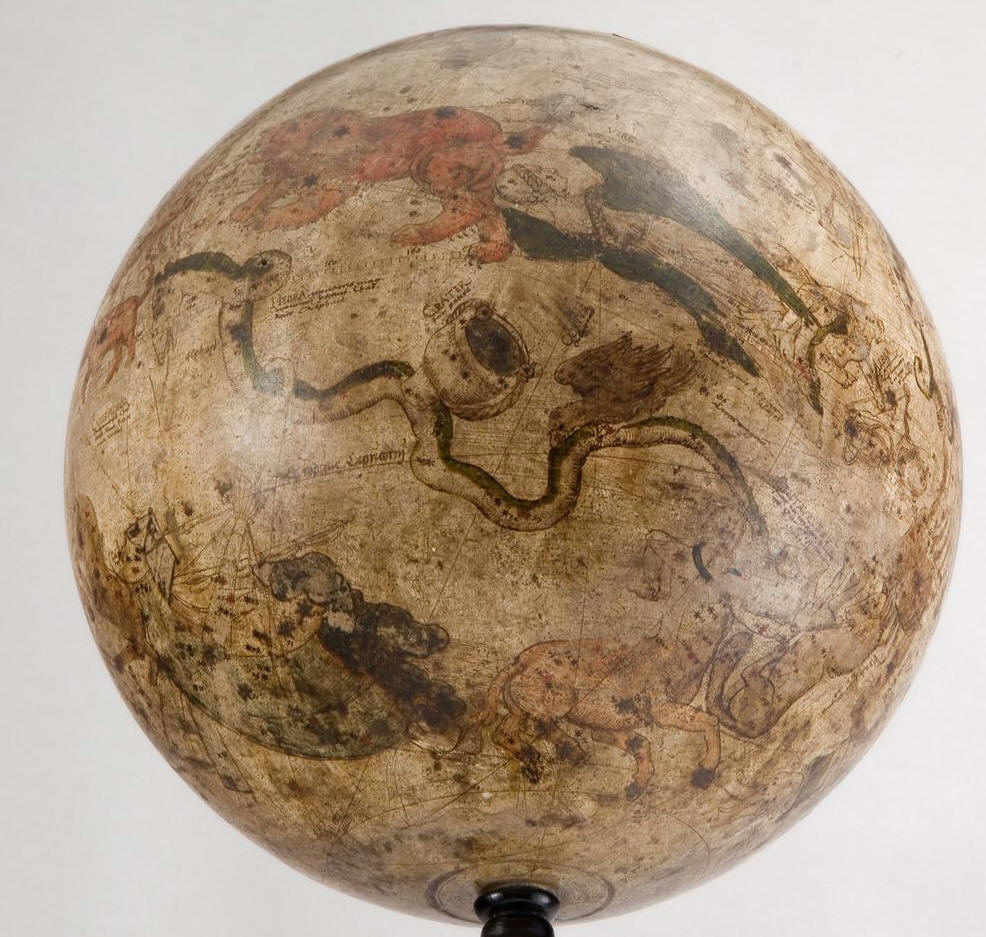
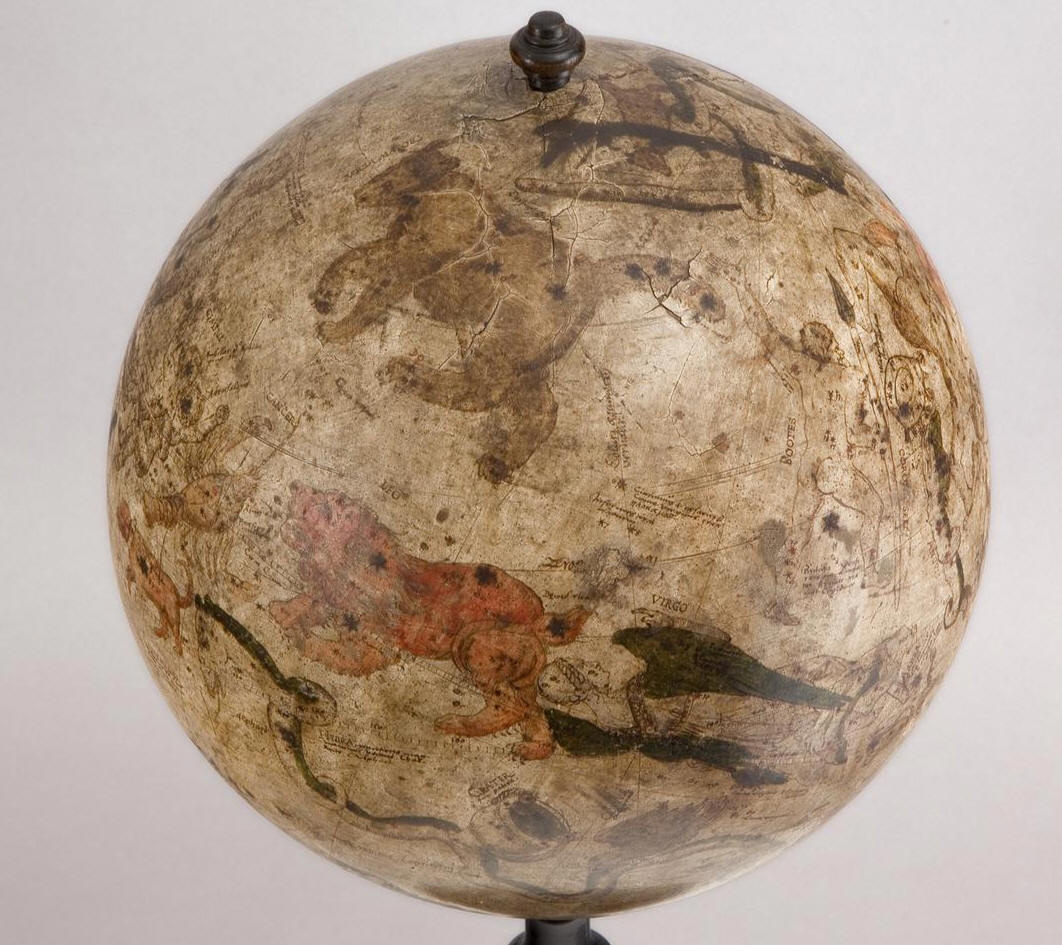
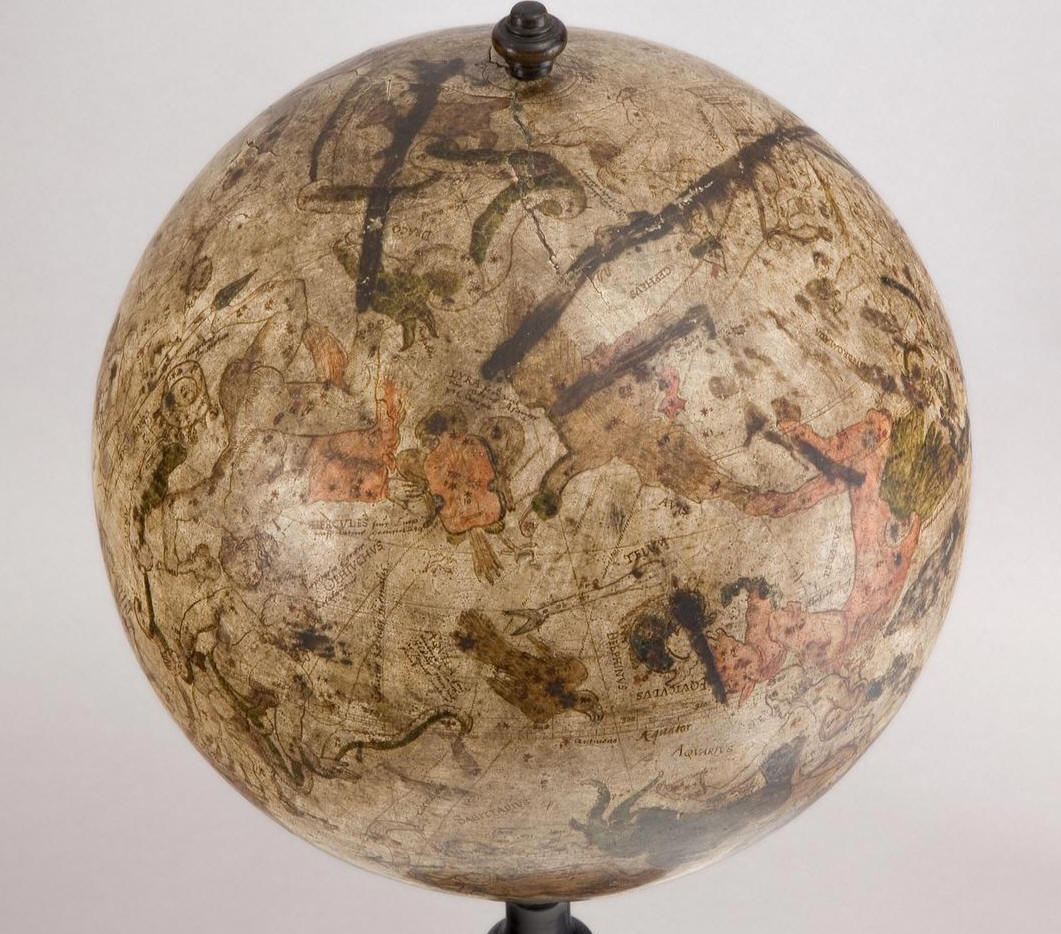
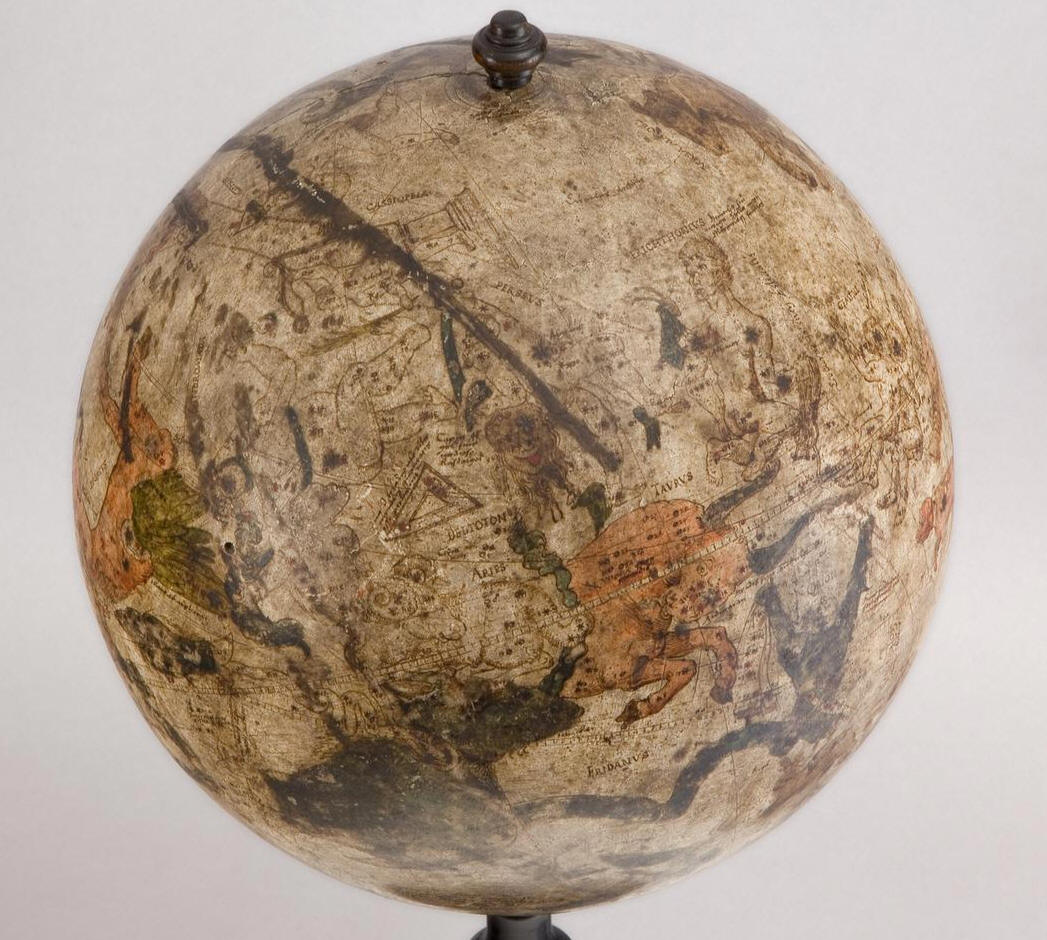
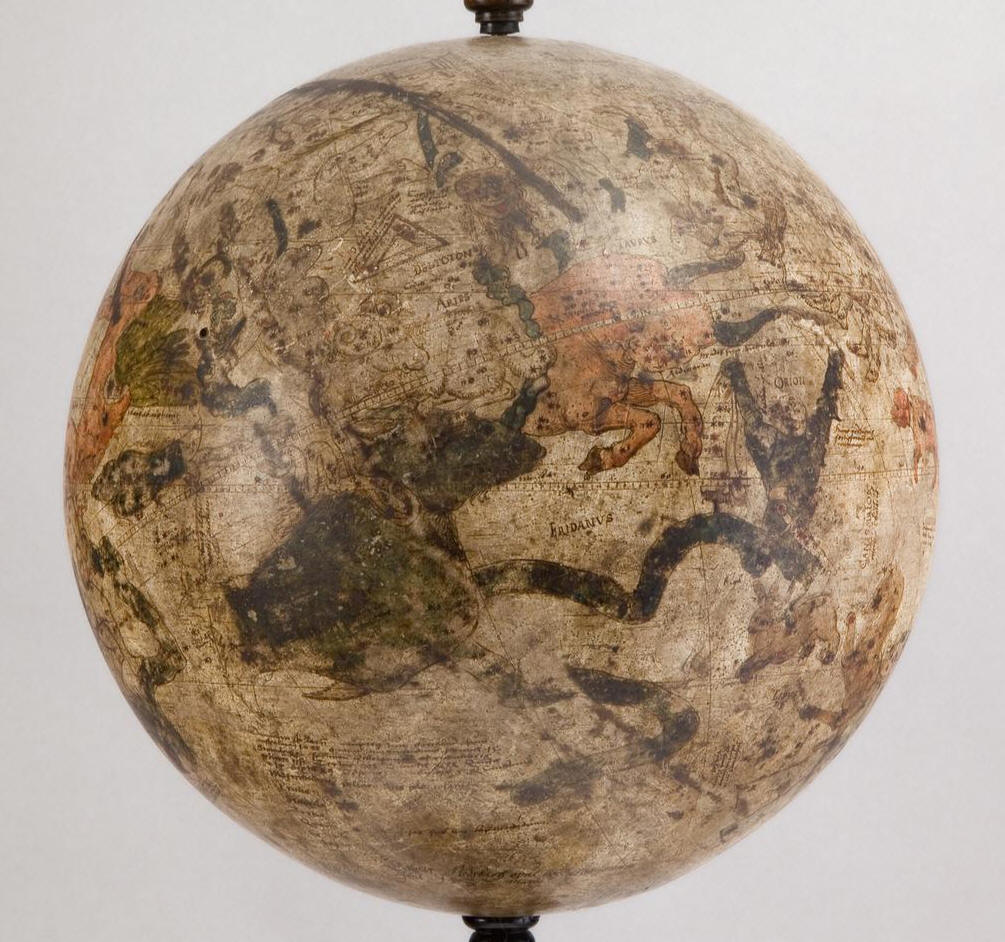
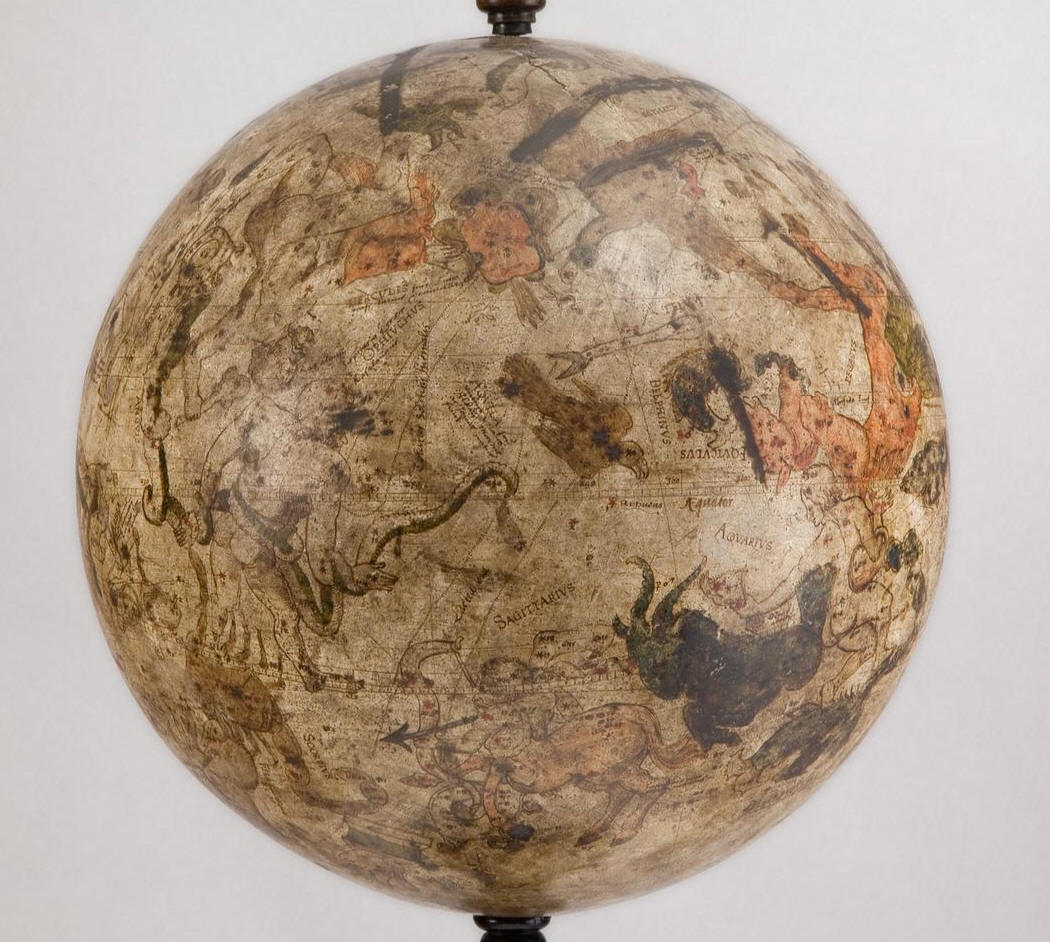
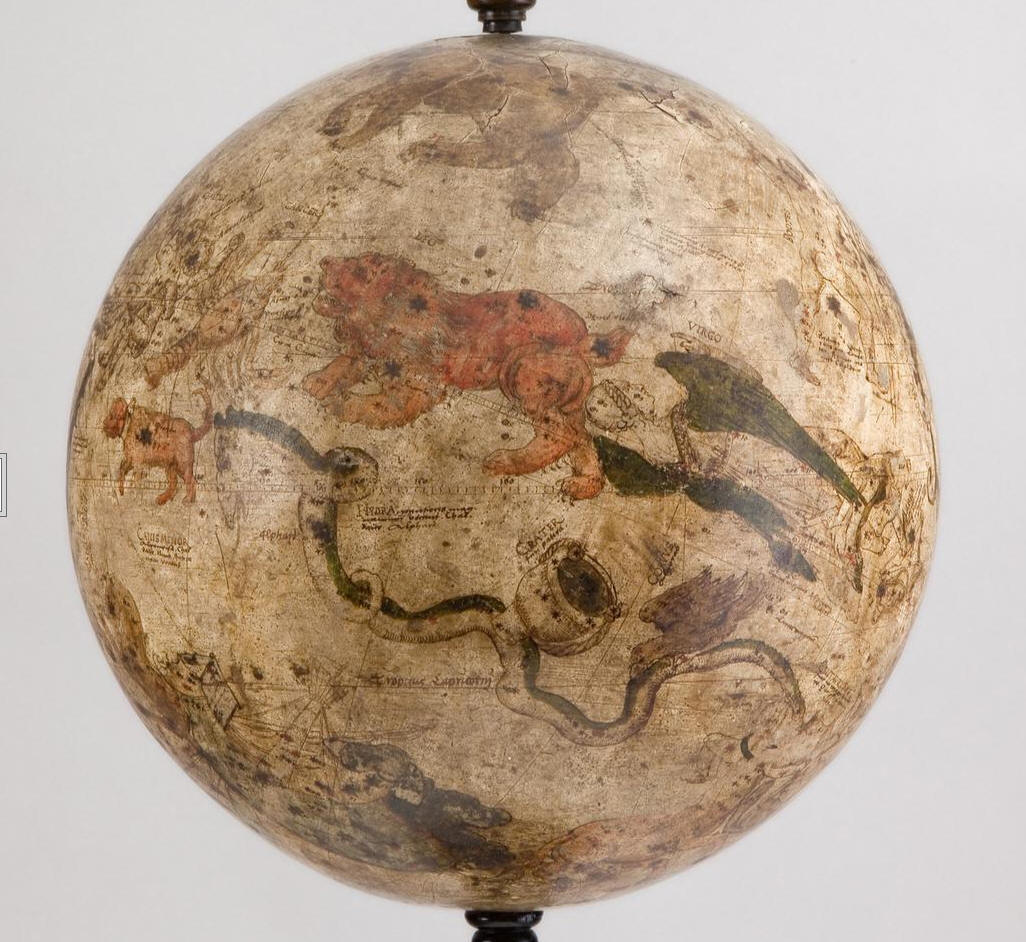
Vopel's earliest surviving piece of
work is his manuscript celestial globe of 1532, now in the Kölnisches
Stadtmuseum. (6)
It has a diameter of some
Like all globes made in the Renaissance, Vopel's presents the 1025 so-called
fixed stars described in the star catalogue in Ptolemy's Syntaxis mathematica,
a second century ad astronomical work devoted to
the motions of the wandering stars, or planets. (8)
The fixed stars, discussed in books
VII and VIII, serve in this context as a reference grid for locating the planets.
The star catalogue is organized as follows:
For each star (taken by constellation), we give, in the first section, its
description as a part of the constellation; in the second section, its position
in longitude, as derived from observation, for the beginning of the reign of
Antoninus…; in the third section we give its distance from the ecliptic in
latitude, to the north or south as the case may be for the particular star; and
in the fourth, the class to which it belongs in magnitude. (9)
The recorded star positions are
valid for the epoch 137 ad, the beginning of the
reign of Antoninus. Since precession causes the equinoxes (the points of
intersection between the ecliptic and the equator) to drift slowly with respect
to the stars in the course of time, the stellar longitudes have to be adapted
for later times.
Ptolemy's Syntaxis mathematica was transmitted to the Latin West
through Arabic translations circulating in Muslim Spain. The Latin translation
made from the Arabic around 1175 by Gerard of Cremona became known in the Middle
Ages as the Almagest; it was first printed in 1515. The epoch of the
catalogue in Gerard's translation was ad 137.
(10)
The star catalogue in the wording of Gerard's translation could also be
found appended to the Latin version of the Alfonsine Tables, a
much-copied work consisting of tables for calculating the positions of the
planets. This ‘Alfonsine catalogue’ is adapted to the epoch 1252 (the
beginning of the reign of King Alfonso X of
The astronomical nomenclature in
the Arabic-Latin catalogue version was understandably permeated with names
originating in transliterations from the Arabic. This Arabic legacy is
recognizable in the hand-written notes on Vopel's manuscript globe. Although
many details are hard to read, and a complete description is still a desideratum,
I can quote, as an example, the text for the constellation
|
The second name given to the
constellation, vultur volans, reflects the indigenous Arabic name used in
the 1515 edition of Ptolemy's star catalogue. (12)
The star name alkaÿr does not occur in that catalogue, however, but
stems from an Arabic-Latin tradition connected with the construction of
astrolabes that goes back to the 980s. (13)
Vopel may have taken this name from the star table in Johannes Stöffler's
influential Elucidatio fabricae ususque astrolabii. (14)
The astrological characteristics of the fixed stars were expressed by means
of the influences thought to be exerted by the planets. Vopel probably obtained
his information from the astrological survey of the fixed stars, Nomina &
qualitates stellarum fixarum secumdum Ptol[lemeum], which was added to the
1524, 1545 and 1553 editions of the Alfonsine Tables. (15)
The names Anhelar and Abrachaleus
for the brightest stars of Gemini (α and β Gem), inscribed on Vopel's
manuscript globe, are not mentioned in the 1515 edition of the star catalogue,
but they are found in the astrological survey in the Alphonsine Tables,
and their use here shows that Vopel knew the Tables.
A number of names on Vopel's manuscript globe cannot be explained by any
source material from the Arabic-Latin tradition. Take, for example, the name Antinous
inscribed below the head of
Its earliest appearance was in the Latin translation made about 1451, at the
request of Pope Nicholas V, directly from the Greek by the humanist George of
Trezibond, or Trapezuntius (1395–1484). The first printed edition of
Trapezuntius's translation appeared only in
Trapezentius's humanist version of the star catalogue differs from Gerard of
Cremona's Latin translation from the Arabic by the use of what humanists
considered ‘good’ Latin. In the translation by Trapezuntius one searches in
vain for names developed from Arabic transliteration. The name Vultur volans,
for
For his figures of the forty-eight constellations Vopel copied the style and
iconography of the pair of maps produced by Albrecht Dürer (1471–1528),
Conrad Heinfogel (1470–1530) and Johann Stabius (d. 1522), and published in
1515. (19)
The iconography of what are usually referred to as Dürer's maps, because it
was he who cut the wood blocks, proved extremely successful throughout the
sixteenth century. It served as the model for the planisphere published by Peter
Apian (1495–1552) in 1536 and reprinted with a different type set in his Astronomicum
Caesarum in 1540. (20)
Planisferi di Conrad Heinfogel (?)
Die Karte des Nördlichen Sternenhimmels, Inv.-Nr. Hz 5576
Die Karte des Südlichen Sternenhimmels, Inv.-Nr. Hz 5577
Petrus Apianus
Astronomicum Caesareum, Ingolstadt 1540
Dürer's figures were also used on the printed celestial globe of 1537
produced by Gemma Frisius (1508–1555) together with Gaspar van der Heyden (c.1496–after
1549) and Gerard Mercator (1512–1595), and on the manuscript celestial globe
made under the supervision of Johannes Praetorius (1537–1616) in 1566. (21)
Belgian celestial table globe, 1537, by van der Hayden, Frisius and Mercator. Royal Museums Greenwich
https://collections.rmg.co.uk/collections/objects/19822.html
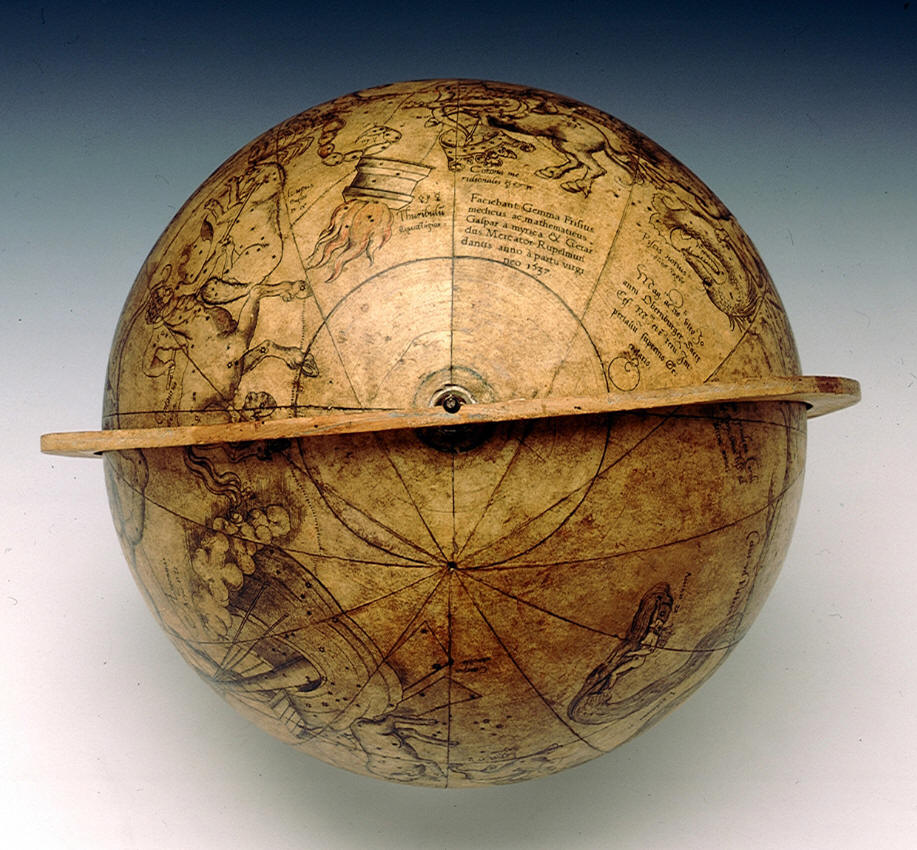
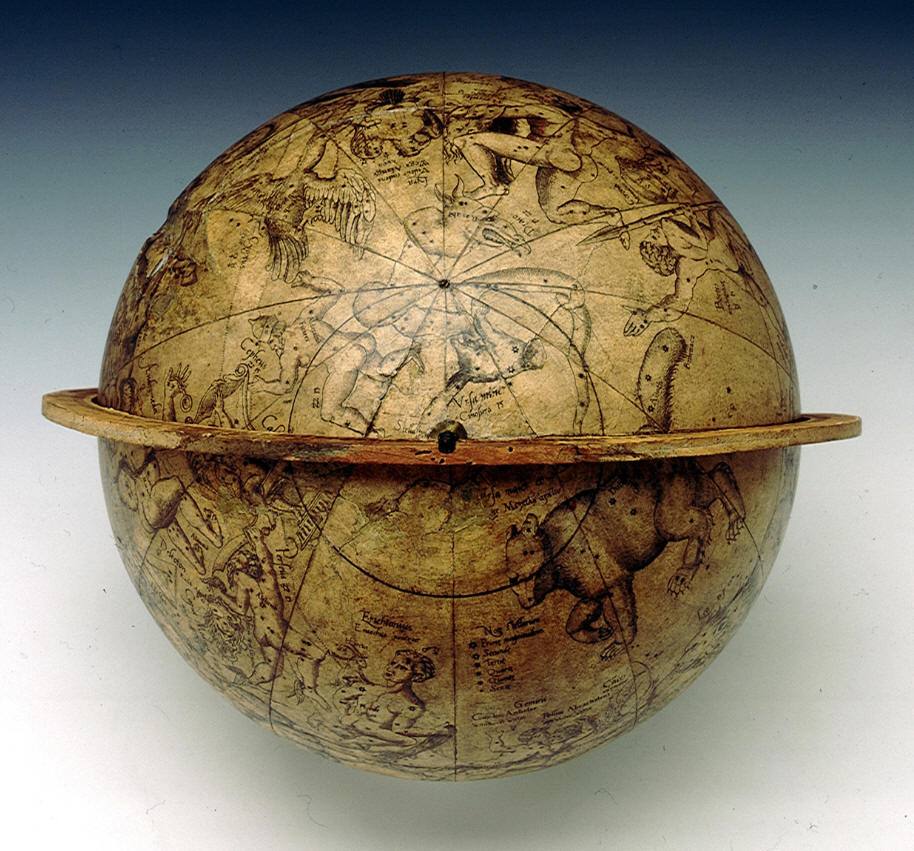
http://www.atlascoelestis.com/Gemma%201537.htm
(vedi in Atlascoelestis:)
Gaius Iulius Hyginus
C. Ivlii Higini, Avgvsti Liberti, Poeticon Astronomicon : Ad Vetervm exemplarium eorumq[ue] manuscriptorum fidem diligentissime recognitum, & ab innumeris, quibus scatebat, uitiis repurgatum, Coloniae 1534
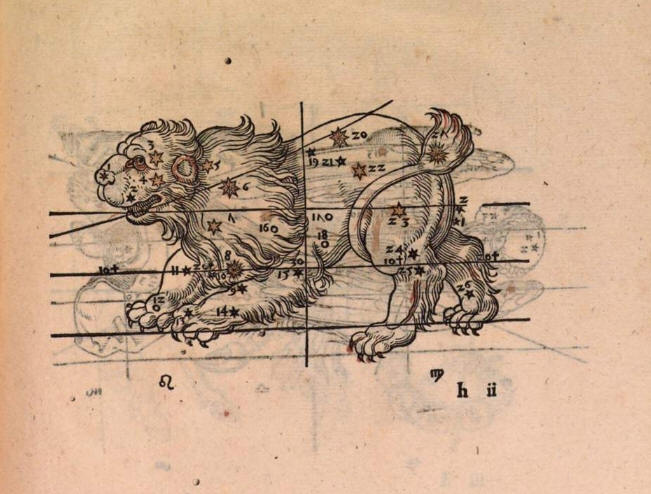
http://www.atlascoelestis.com/Hyginusvopel%201534.htm
Vopel's next undertaking in
celestial cartography was the series of forty woodcut constellation images made
for the 1534 edition of the Poeticon Astronomicon, published by the
Cologne humanist and printer Johannes Soter. (22)
This astronomical treatise on the rudiments of astronomy is attributed to
the librarian of the Roman emperor Augustus, C. Iulius Hyginus (first century bc).
Vopel's involvement in Soter's edition is expressed in an address to the reader
printed at the end of the book. He also included a reference to his woodcut
illustrations of Hyginus's Poeticon Astronomicon in a legend on his world
map. (23)
Cycles of individual constellation images are seen in many medieval
manuscripts, where they illustrate so-called descriptive star catalogues, that
is, written lists of the locations of stars within constellation images. The
oldest extant copies of such lists date from the beginning of the ninth century.
Some descriptive star catalogues are part of the scholia of Latin translations
of the Phaenomena, the earliest surviving Greek description of the
celestial sky by Aratus of Soli (c. 310–240/239 bc);
others occur in treatises of the ‘computus’. (24)
Book III of Hyginus's Poeticon
Astronomicon contains such a descriptive star catalogue.
The most common cycle of constellation images printed in the Renaissance is
the one illustrating the editio princeps of the Latin translation of
Aratus's poem by Germanus Iulius Caesar (15 bc–19
ad). This was published in
The woodcuts of the Scot illustrations were also used in the 1482 and 1485
editions of Hyginus's Poeticon Astronomicon, published by Erhard Ratdolt
in
In contrast, the
The images of Andromeda in the editions by Ratdolt and Soter of respectively
1482 and 1534 are shown in Figure 2 The 1482 image depicts Andromeda as a male/female
with outstretched arms tied to the branches of trees. (27)
The stars plotted in the constellation are in keeping with Hyginus's
descriptive star catalogue. Vopel's image on the other hand follows Dürer's
design of a naked woman in chains. He placed the constellation in relation to
sections of a number of celestial circles: great circles through the ecliptic
poles separating the signs of the zodiac, the Tropic of Cancer and the
equinoctial colure. In the absence of declination scales it is not possible to
decide what sort of projection Vopel used, but it certainly was not
stereographic. The great circles through the ecliptic poles in the woodcuts in
Soter's Poeticon Astronomicon seem to represent the boundaries of globe
gores and clearly anticipate Vopel's printed globe. It is, therefore, not
surprising that the stars in Vopel's figure of Andromeda do not follow Hyginus's
descriptive star catalogue, but are based on Ptolemy's positions and magnitudes
of the stars and are numbered according to their order in his star catalogue.
(28)
|
The principles underlying Vopel's
woodcut of Andromeda hold for the other constellations. A few, however, diverge
from the general pattern. For example, the iconography of Boötes deviates from
Dürer's design in that Boötes now holds a sickle in his raised left hand, a
detail that Vopel borrowed from the Scot illustration, where Boötes is
portrayed as a farmer (Fig. 3).
|
Fig.
3.
Boötes from two editions of Hyginus, Poeticon Astronomicon.
Woodcuts. Left, the Radolt edition of 1482, portraying Boötes as a farmer.
Right, the Soter edition of 1534, where Boötes holds a sickle in his
raised left hand, a detail borrowed from the illustration in the Radolt
edition. (Reproduced with permission from the History of Science
Collections,
|
In some constellations unformed
stars or stars belonging to a neighbouring constellation are found. For example,
the image of Corona Borealis contains some stars from Serpens (Ser 1–3,
5–6), and included in the outline of Taurus are two non-Ptolemaic stars (numbered
34 and 35 and placed after the Ptolemaic Pleiades stars 30–33) and the Greek
names of the Pleiades and the Hyades (Fig. 4). Hyginus discussed the Pleiades in
a separate entry in Book II.21, declaring that only six of its seven stars were
discernable. This could explain why Vopel increased the four Ptolemaic Pleiades
stars to six. The one star name shown in Vopel's drawings, CANOPVS in
Navis, is also discussed by Hyginus, although not in his entries on Navis (Books
II.37 and III.36) but in the entry on Eridanus (Book II.32). All this suggests
that the images were taken from something much larger, such as a set of globe
gores. The rough scale (in units of 10°) for longitudes that accompanies the
drawings of the zodiacal constellations is consistent with this thesis.
|
Since
the Ptolemaic stellar configurations of Vopel's constellation cycle are not in
line with Hyginus's descriptive star catalogue, the series must have confused
readers trying to connect the text with the images. This did not, however,
prevent the reproduction of either the whole cycle or part of it in a number of
astronomical works printed later in the sixteenth century. (29)
(Nota di Atlascoelestis):
Si pensa che gli stessi stampi in legno di Vopel siano atati utilizzati nell'officina tipografica di Theodorus Graminaeus per stampare le xilografie delle costellazioni utilizzate per l'edizione del 1569 e 1570 (vedi: https://www.astronomie-nuernberg.de/index.php?category=duerer&page=graminaeus-1569) , di
Arati Solensis
PHAENOMENA ET PROGNOSTICA. Interpretibus M. Tullio Cicerone, Rufo Festo
Avieno, Germanico Caesare, Una cum Eius Commentariis. C.
Iulii Hygini Astronomicon...
Coloniae Agrippinae (
http://www.atlascoelestis.com/Aratus%20Solensis.htm
L'opera può essere consultata
nella seguente pagina
per cortesia di

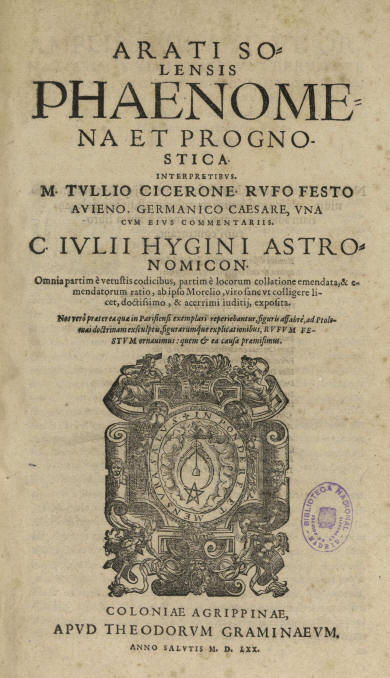
http://bdh-rd.bne.es/viewer.vm?id=0000000204
e per cortesia di

in
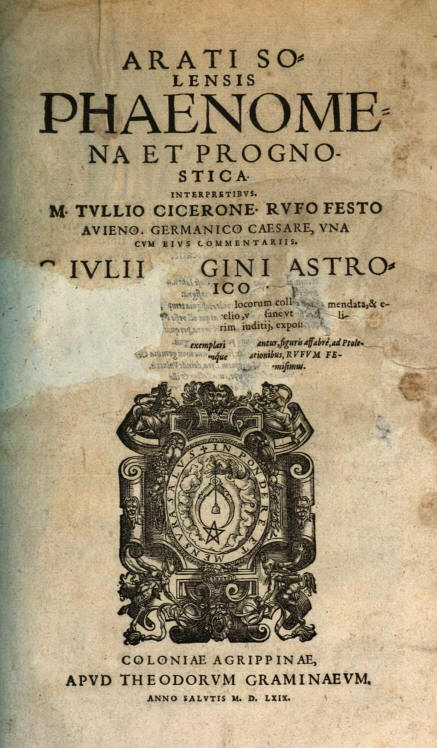
https://reader.digitale-sammlungen.de/resolve/display/bsb10139476.html
Vedi: https://www.bildindex.de/document/obj05741338 e http://www.atlascoelestis.com/Anonimo%20vopel%201536%20base.htm, nota di Atlascoelestis
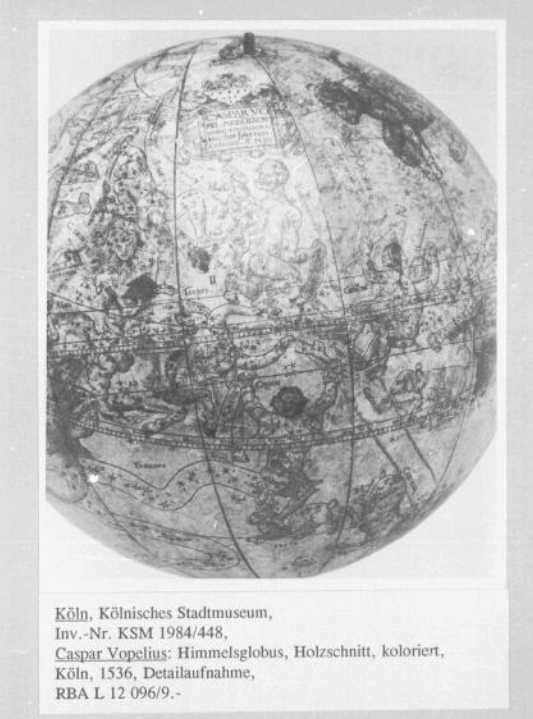
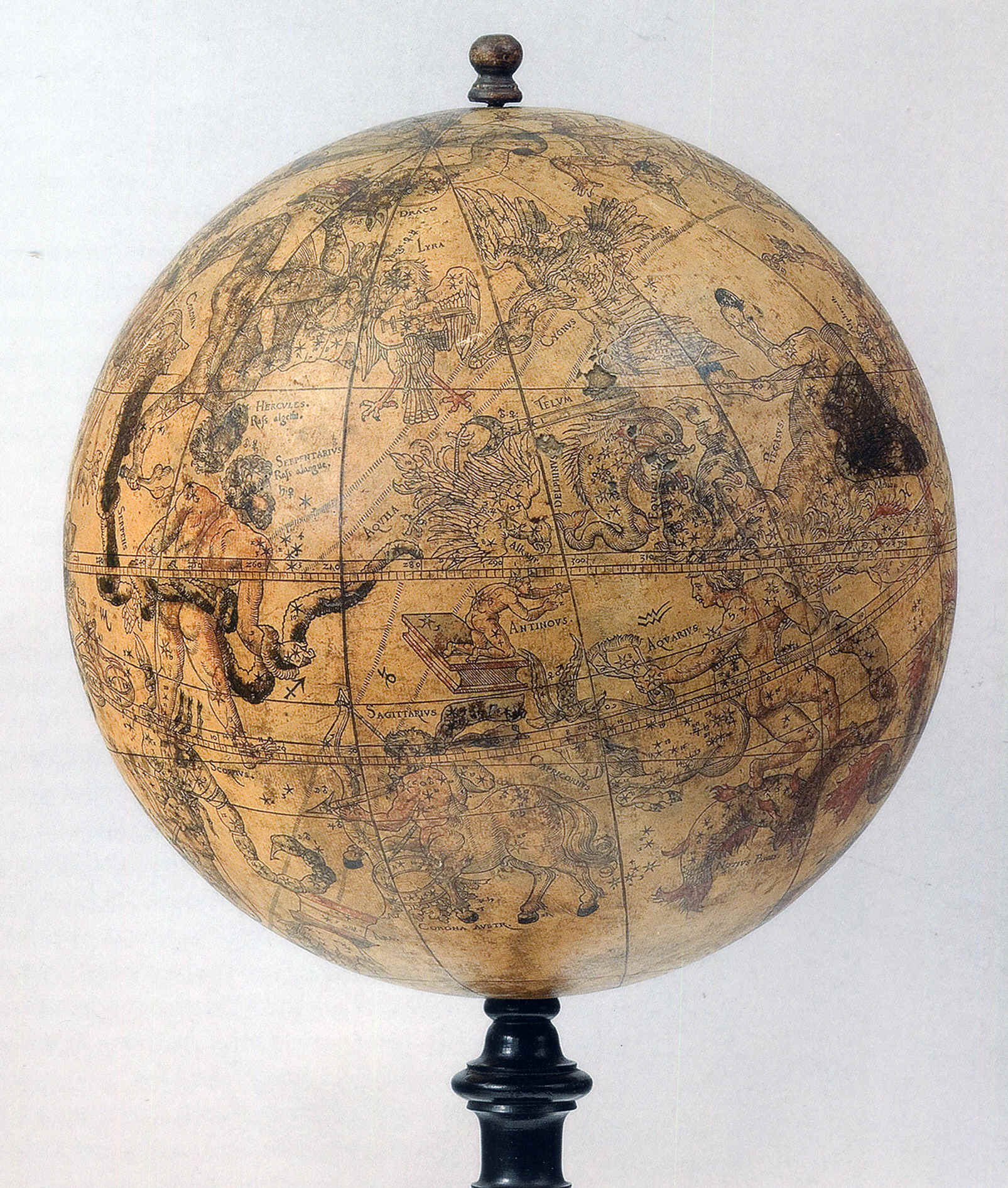
Vopel's manuscript globe of 1532
and his series of woodcuts of 1534 supposedly served as trials for the
production of the woodcut gores for his printed globe with the inscription: CASPAR.
VO/PEL. MEDEBACH / HANC. COSMOGRA: / faciebat sphæram. / Coloniæ. A°. 1536
(Fig. 5). The design of this globe (described in Appendix 1 as G1) follows in
many respects that of the earlier manuscript globe. Its nomenclature, however,
is less extensive, presumably because it is easier to make handwritten notes
than to cut lengthy texts in wood. Thus
Vopel's example was followed on the
celestial globe of 1537 by Gemma Frisius and his collaborators and on that of
1551 by Gerard Mercator. (31)
|
A comparison of Vopel's manuscript
globe with the printed one shows changes in the stellar positions. For example,
the stars in the tail of Aries (Ari 9–10) lie south of the ecliptic on the
manuscript globe but north of it on the printed one. The star at the end of the
chain of Andromeda (And 23) stands in the middle of the sign of Aries on the
manuscript globe and at the beginning on the printed globe. On Vopel's woodcut
of Aries in the 1534 edition of Hyginus, the stars Ari 9–10 are still shown
south of the ecliptic, whereas on the woodcut of Andromeda the star And 23 is
located at the beginning of the sign of Aries (see Fig. 2). Such variations in
position show that Vopel was continuously adapting his mapping.
Positional differences are not
necessarily the result of careless work by the mapmaker but may reflect the use
of a specific version of the Ptolemaic catalogue. Comparable variations are
noticeable in contemporary sources. On Dürer's maps (1515), Apian's
planispheres of 1536 and 1540, and Gemma Frisius's celestial globe of 1537, the
stars Ari 9–10 are south of the ecliptic and the star And 23 is in the middle
of the sign of Aries. On the globe gores cut in wood in 1515 by Johannes Schöner
(1477–1547) and on Mercator's globe of 1551 the stars Ari 9–10 are north of
the ecliptic and the star And 23 is at the beginning of the sign of Aries.
The most important characteristic
of Vopel's printed globe is a series of iconographic peculiarities that do not
derive from Dürer's maps. They also do not occur on the manuscript globe or on
the woodcuts in the 1534 edition of Hyginus. This series is comprised by images
for Antinous and Coma Berenices, Boötes accompanied by hunting dogs and a goat
eating leaves from a vine above his head, the Wagon (Plaustrum) in the
body and tail of Ursa Maior, the Kids (Haedi) in Auriga, six tiny female
heads illustrating the Pleiades (Vergiliae) in Taurus, two Asses (Asini)
in Cancer, Lyra as a bird with a stringed instrument placed horizontally over
its body, and one of the Gemini with a lyre or a similar instrument with bow.
These features are discussed separately below.
Vopel's printed globe attracted a number of imitators. Two sets of
copperplate gores and one set of mounted woodcut gores (described in Appendix 1,
G2–G4) appear to be close copies of Vopel's printed globe. (32)
The anonymous engraver of the G2
gores acknowledged his source: SPHAERA / ASTRONOMICA / aeri exarata, sicut /
eam olim exhibuit Cas/par Vopelius Cosmogr. (Fig. 6). It is tempting to
identify these G2 gores with those used for making the celestial globe of the
pair by Johannes Antonii Barvicius reported to have been published in
|
Fig.
6.
Gores of an anonymous copy of Vopel's printed globe of 1536 (G2 in
Appendix 1). The enlargements 1 to 4 show, respectively, the small images
of the Pliades, the Kids, the Lyre of the western Twin, and the Asses.
Sotheby's, Catalogue Natural History, Travel, Atlases and Maps (
|
The makers of the G3 copperplate
gores and the G4 globe do not mention Vopel. A comparison with Vopel's printed
globe shows that the G3 gores were not copied particularly carefully and may
well have been the work of an amateur. The engraver has omitted the names of
five constellations and given only one of the star names marked on Vopel's
printed globe (see Appendix 1, G3). The G4 celestial globe belongs to a pair of
which the terrestrial globe does not follow any of the editions of Vopel's
terrestrial globe. The G4 gores are woodcuts, as are those of Vopel's printed
globe. The maker included only five star names, two of which do not stem from
Vopel's globe (see Appendix 1, G4). The most striking deviation from Vopel's
1536 globe is the image of a young man representing Phaeton placed at the end of
Eridanus, which is first seen on the copperplate celestial globe gores by François
Demongenet, published around 1560. (34)
Il globo celeste di Vopel del 1536 ha ispirato anche quello prodotto da Christoph Schissler ad Augusta nel 1575, diametro 42cm:
“CHRISTOPHORVS SCHISSLERVS AVGVSTANVS GEOMETRICVS ET ASTRONOMICVS FABER GLOBVM HVNC CÆLESTREM FACIEBAT ET DESCRIBEBAT ANNO DOMINI 1575”
“STELLÆ HVIVS GLOBI NVMERATÆ AC DISTRIBVTÆ SVNT SECVNDVM CVRSVM SPHÆRÆ OCTAVÆ AD NOSTRVM TEMPVS ANNVMQVE ACCOMMODATÆ 1575“
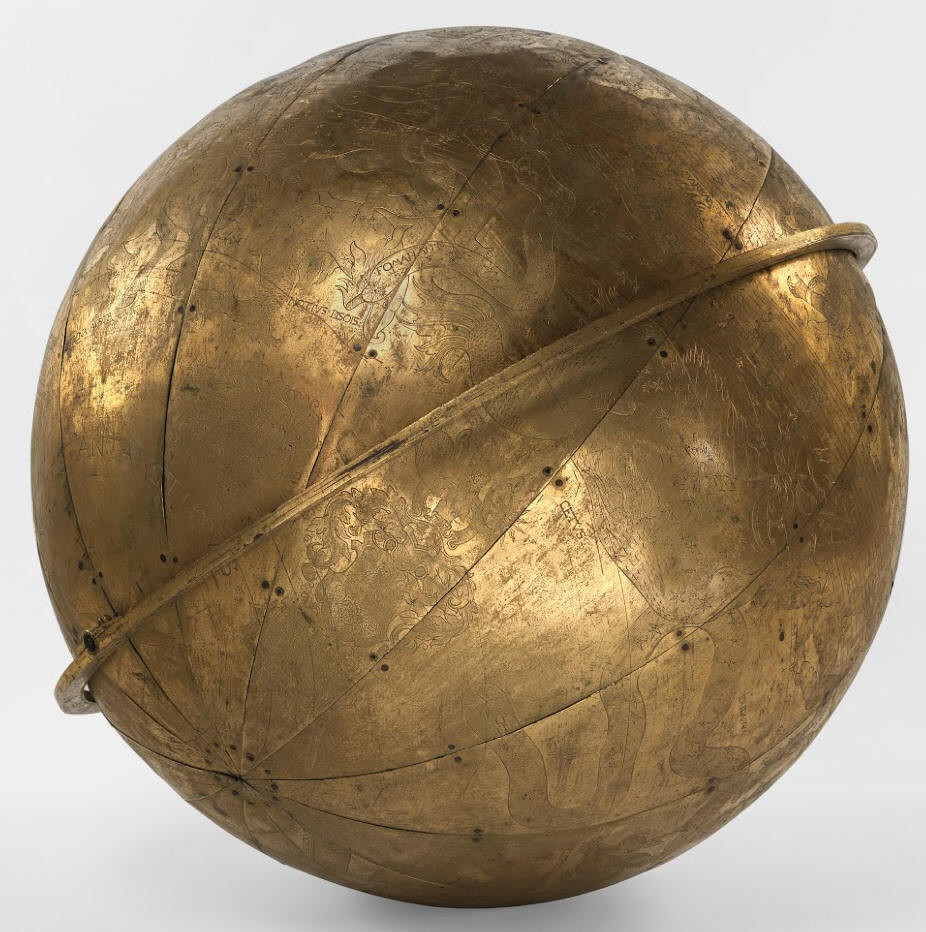
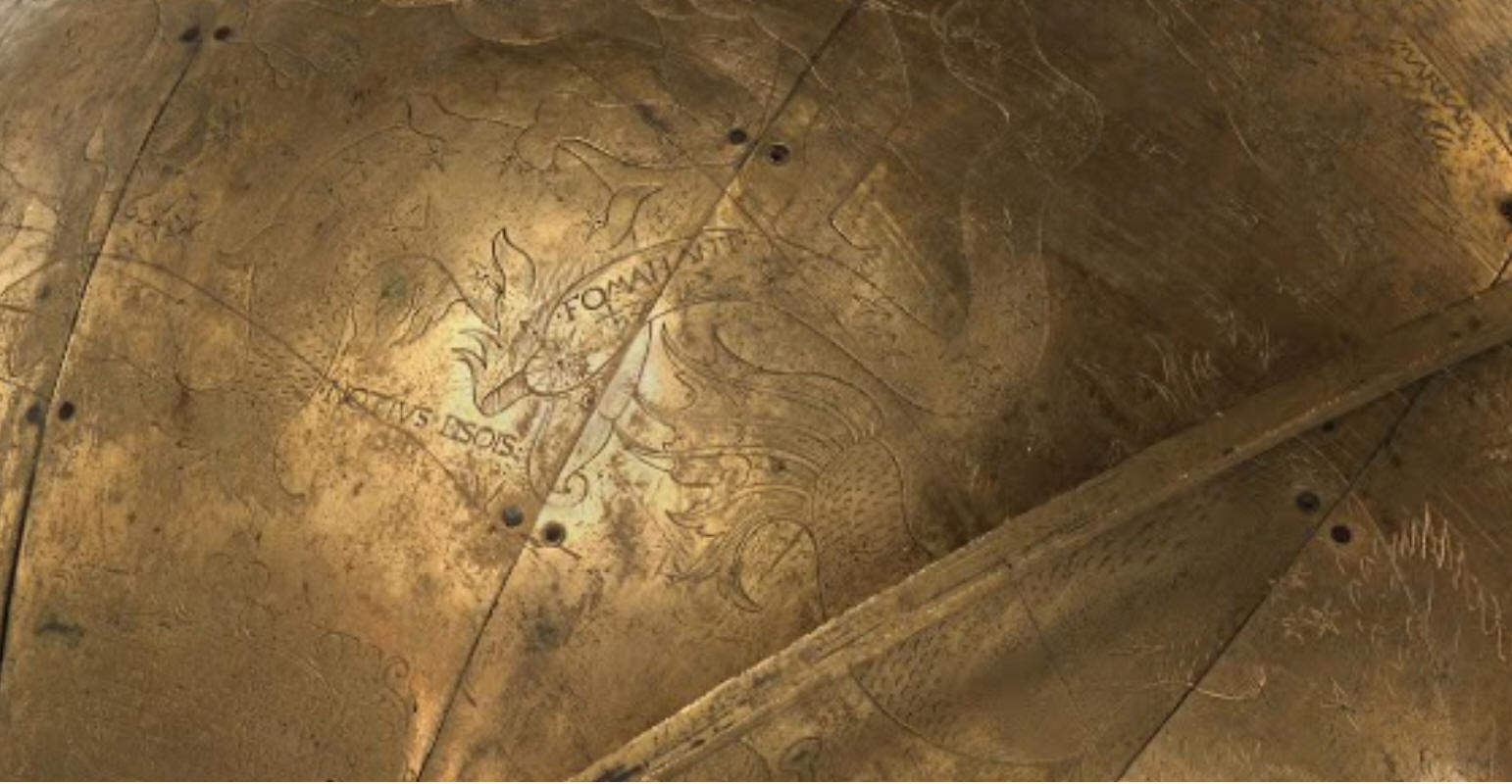
https://www.parquesdesintra.pt/pontos-de-atracao/globo-celeste/
https://www.astronomie-nuernberg.de/index.php?category=duerer&page=schissler-1575
E ha anche ispirato un globo in rame di 29 cm di autore anonimo e di epoca imprecisata ora esposto al

https://collections.rmg.co.uk/collections/objects/19782.html
https://www.astronomie-nuernberg.de/index.php?category=duerer&page=anonym-15xx
https://www.astronomie-nuernberg.de/index.php?category=duerer&page=nachfolger
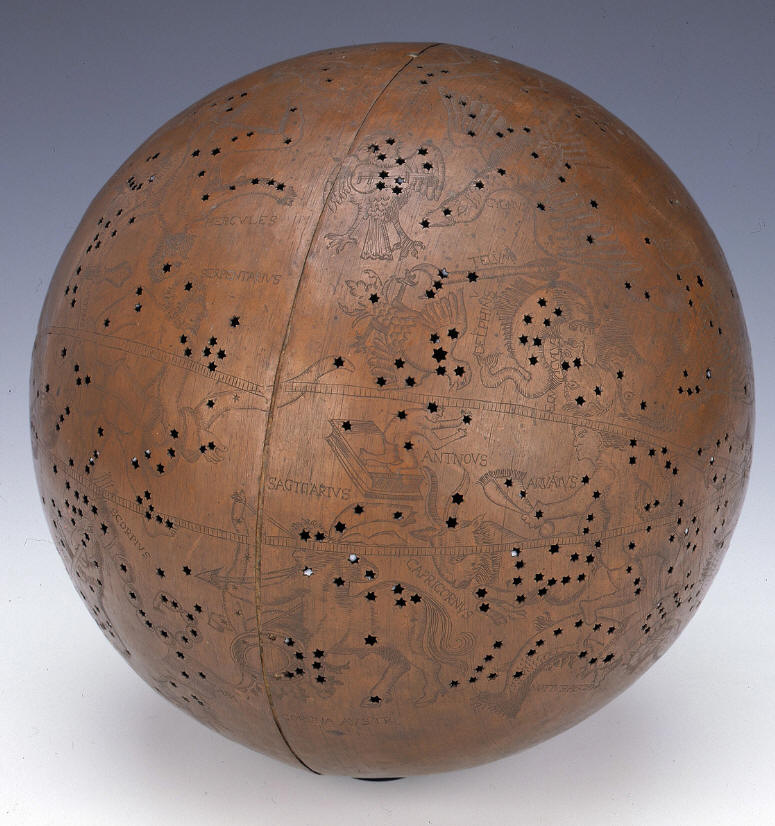
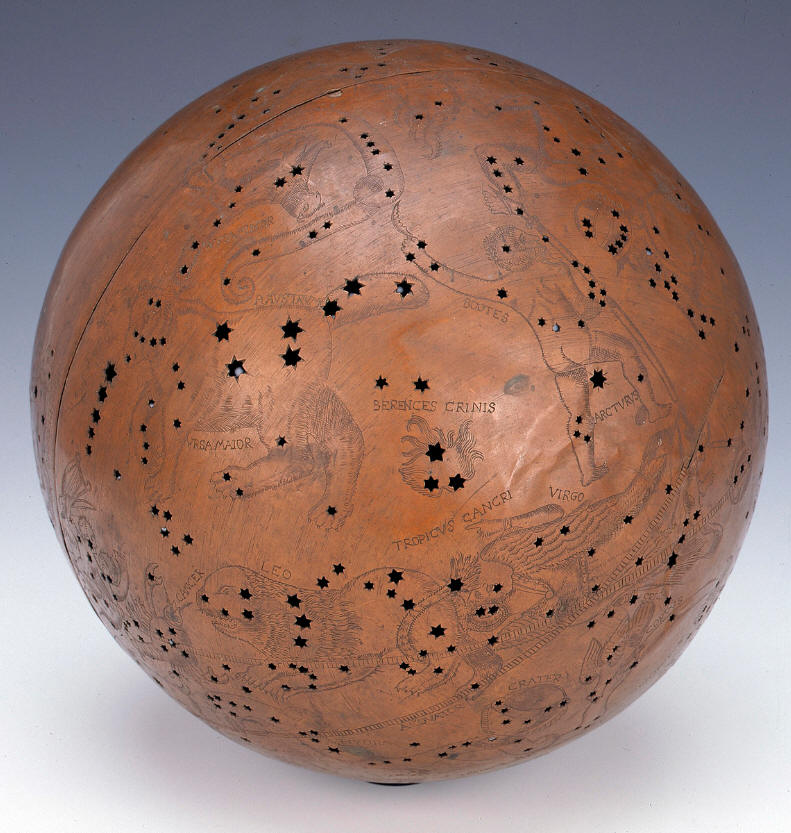
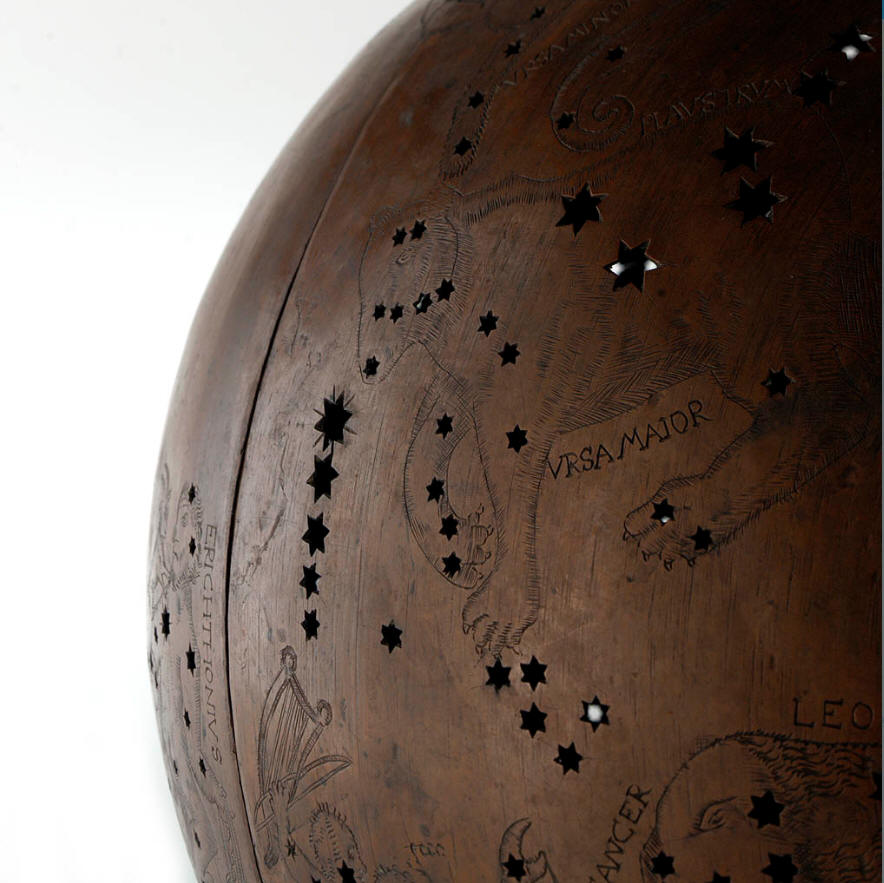
In 1545 Vopel published a world map
in which the northern and southern celestial hemispheres occupy, respectively,
the lower left and right corners. (35)
A second edition was published in 1549, and further editions may have
appeared in the 1550s. (36)
No example of Vopel's world map has survived, but a number of derivatives
are known. The celestial maps on these are described in Appendix 2 as M1, M2 and
M4. (37)
The celestial maps (M1) on the
world map by Jeronimo de Girava of 1556 are only rough copies and show just
enough detail to make the model recognizable. A much better impression of
Vopel's celestial maps is obtained from the close copies of his world map by
Giovanni Andrea Valvassore (M2) of 1558, shown in Plates 7 and 8, and by
Bernaard van den Putte (M4) of
At first sight the celestial maps on Valvassore's and Van den Putte's world
maps seem to be no more than copies of Dürer's maps. Valvassore and Van den
Putte reproduce the titles along the top and the images of Aratus, Manilius,
Ptolemy and al-![]() ūfī
that are found in the corners of Dürer's northern hemisphere. However, the maps
are not slavish copies of Dürer's. The stars on Valvassore's and Van den
Putte's celestial maps are coded on a six-point scale given on the map ( Fig. 7)
according to their brightness. Many stars are named and accompanied by planetary
symbols. Valvassore's and Van den Putte's celestial maps include a number of
names not seen on Vopel's printed globe. For example, three names (Βασιλισκος
/ Regulus / Cabalezet) for the bright star α Leo are added. The
first and the last of these names stem from respectively the Greek and Arabic
tradition. The name Regulus is a concoction of the early sixteenth
century humanist astronomers. (38)
ūfī
that are found in the corners of Dürer's northern hemisphere. However, the maps
are not slavish copies of Dürer's. The stars on Valvassore's and Van den
Putte's celestial maps are coded on a six-point scale given on the map ( Fig. 7)
according to their brightness. Many stars are named and accompanied by planetary
symbols. Valvassore's and Van den Putte's celestial maps include a number of
names not seen on Vopel's printed globe. For example, three names (Βασιλισκος
/ Regulus / Cabalezet) for the bright star α Leo are added. The
first and the last of these names stem from respectively the Greek and Arabic
tradition. The name Regulus is a concoction of the early sixteenth
century humanist astronomers. (38)
Other names, such as the two in
Eridanus, Acarnar and Angetenar, appear to stem from the star
catalogue appended to the Alfonsine Tables. Especially striking is the
addition of Greek names for many constellations (
|
Fig.
7.
Table with the marks for stars with magnitudes 1 to 6, together with the
number of stars in each magnitude class, in the right lower corner on
northern celestial hemisphere from the world map by Giovanni Andrea
Valvassore (
|
|
||
|
|

Many but not all the iconographic
peculiarities introduced on Vopel's printed globe seem to have been reproduced
on the celestial maps on his world map, when judged by its copies. All maps M1
to M5 contain the images of Coma Berenices and Antinous. M1 to M4 depict Boötes
with sickle, club and dogs, and M2 to M4 also have the vine-eating goat. Missing
on all the maps (M1–M5), and very likely also on Vopel's, are the Wagon in
Ursa Maior, the Pleiades, the Kids and the Asses. The last three images may have
been too tiny to be added to a map, and presumably these images were already
lacking on Vopel's map. The absence of the Wagon may have been provoked by the
polar stereographic projection of the celestial maps, which results in some
congestion of the constellations around the North Pole. This could also explain
why the name of the Wagon (Plaustrum) is found near the head instead of
near the tail of Ursa Maior. However, the new location of the name Plaustrum
may derive from Apian's planispheres of 1536 and 1540, from which the non-linear
scale for measuring latitudes was borrowed.
All the celestial maps (M1–M5) display two iconographic characteristics
that define them as a group and that are not found on Vopel's globes. One is a
cloud of smoke rising from the flames on top of the altar of Ara; the other is a
swimming female at the end of Eridanus (see Plate 8). Medieval illustrations of
Eridanus associate the constellation with the river god, and this is how
Eridanus is depicted in the 1482 edition of Hyginus. (39)
In some editions of Hyginus's fables, however, the figure at the end of the
river is a swimming maiden; this is what we find on Apian's planispheres of 1536
and 1540, on the globe of Gemma Frisius of 1537, on the globe gores of Georg
Hartmann of 1538, and on Demongenet's woodcut gores of 1552. (40)
The popularity of the swimming
maiden at the end of Eridanus may have been the reason why Vopel decided to
introduce it on his celestial maps of 1545.
|

It is not a priori clear how the
various copies of Vopel's celestial maps are interrelated. Since the world maps
of Valvassore and Van den Putte are close in content, it has been suggested that
Van den Putte's world map was based on the earlier one of Valvassore. (41)
Details in the nomenclature of the celestial maps, however, show that the
two world maps may be independent copies. For example, on Van den Putte's
celestial maps (M4), one finds the Greek name of the Gemini, the four Ptolemaic
and the two extra non-Ptolemaic stars of the Pleiades and their Latin name Vergiliae,
the Latin Hædi for the Kids in Auriga, and the star names Alhabor
(α CMa) and Bellatrix (α Ori). None of these names occurs on
Valvassore's copy (M2). The same features are missing from the celestial maps of
Pagano (M3). Valvassore's and Pagano's celestial maps also share a number of
spelling errors, for example, Makab (α Peg) instead of Markab,
which do not occur on Van den Putte's map. Since Pagano's maps are less complete
than those of Valvassore, the common omissions and spelling errors suggest that
Pagano used the celestial maps on Valvassore's world map as his model and not
the other way round. His world map should therefore be dated later than 1558.
(42)
Another detail concerns the image
of Lyra. On the copies of Vopel's celestial maps Lyra is depicted with the
stringed instrument arranged vertically as on Dürer's maps instead of
horizontally as on Vopel's printed globe. Although it is hard to say why Vopel
should have returned to Dürer's Lyra, the change is not particularly
significant, since this is the way Vopel had already depicted Lyra on his
Hyginus drawing and on his manuscript globe (see Fig. 1). What is of interest
here is that on three maps (M1–M3) the bird is now headless, which suggests
that this was a characteristic of the models used for these maps. The presence
of a ‘headed’ bird on Van den Putte's celestial maps, together with the
additional names and the Pleiades stars, suggest that Van den Putte used one of
the later editions of Vopel's world map with alterations made by Vopel himself.
In conclusion, it is worth noting that no other Renaissance celestial maps
are known that offer as many details as Vopel's, when judged by its copies. The
addition of celestial maps on a world map is another matter. (43)
This was not merely symbolic, but a
gesture designed to present a complete image of the cosmos. The concept must
have appealed to Renaissance mapmakers, since later in the sixteenth century
Vopel's example was followed by many mapmakers besides those copying his world
map. (44)
As already noted, Vopel's printed
globe of 1536 is characterized by a series of conspicuous iconographic features
that are discussed here in greater detail. The features are not of equal
importance. Some, such as the tiny figures of the Pleiades, the Asses and the
Kids, are more like mythological footnotes in the iconographic landscape (see
Fig. 6). These star groups were recognized early in Greek astronomy, and images
of them in medieval illustrated manuscripts are not unknown, but I have never
seen the Pleiades and the Asses represented graphically on any other celestial
globe, and the Kids are only on globes postdating Vopel's printed globe. (45)
The lyre held by the western twin in Gemini is another minor feature (see
Fig. 6). The names Anhelar (α Gem) and Abrachaleus (β
Gem) indicate that Vopel had identified the Gemini as Apollo and Hercules, the
Latin names of which were added on Vopel's celestial maps (see Plate 7 and
Appendix 2). (46)
Vopel emphasized this identification by giving the western twin the lyre,
thus recalling the well-known myth that Hermes offered Apollo the lyre as
compensation for his attempt to steal Apollo's herd. (47)
On Schöner's woodcut globe gores of 1515 the western figure in the Gemini
has a violin-like instrument as an attribute that is seen also on his later
globe of c.1533, where he added the star names Apollinis and Herculis.
(48)
The mythological background for the
iconography of Boötes is more complicated. This classical hero is represented
on Vopel's printed globe as a naked bearded man with a sickle in his raised left
hand and a lance in his right hand (Fig. 8). On his right side is a pair of dogs
on a lead, which he holds in his right hand. Above his head is a goat eating
leaves from a vine. The 1534 woodcut of Boötes (see Fig. 3) can account for the
main figure holding a lance in the one hand and a sickle in the other, but where
did the other features come from?
|
Fig.
8.
Boötes on Vopel's printed globe of 1536. (Reproduced with permission from
the Director of the Graphische Sammlung of the Kölnische Stadtmuseum.)
|
The image of a vine with the
leaf-eating goat finds its origin in the myth connecting Boötes with Icarius.
This story survives today only in Book II.4 of Hyginus's Poeticon
Astronomicon:
Many say that this [the constellation Boötes] is Icarius, the father of
Erigone. To him, because of his justice and piety, Liber granted wine, the vine,
and the grape, so that Icarius might show mankind in what way the vine should be
cultivated, what grows from it, and when it is grown, how it should be used.
When he had planted the vine and by diligent pruning made it sprout, it is said
that a goat fell on the vine and picked off all the tender leaves it found there.
Icarius became so irritated that he killed the goat, made a bag out of its skin,
filled the bag with air then tied it, and throwing it among his companions
ordered them to dance around it. And so as Eratosthenes says, ‘Men first
danced around the goat of Icarius’. (49)
Some scholars believe that Hyginus took this story from a lost poem, Erigone,
by Eratosthenes describing the drama of Icarius. (50)
The main story, also told by
Hyginus, relates how Icarius, after receiving the gift of wine, completely
filled an ox-cart with wineskins and offered the wine to shepherds all around
The first stage of the story is depicted in a mosaic in the House of
Dionysus, in Nea Paphos in
Vopel has here combined the story of Icarius with another tale connected
with the seven stars of Ursa Maior, known in antiquity as the Wagon or Wain or
by its Roman name Plaustrum. (52)
|
Fig.
9.
Panel with Dionysos (on the left) presenting the gift of wine to Icarius
(in the middle) who holds the reins of an oxcart filled with wineskins. On
the right are two shepherds, the first wine drinkers according to the
inscription, who became drunk after tasting the gift. From a mosaic in the
House of Dionysus, in Nea Paphos in
|
|
Hyginus also mentions this star
group in his description in Book II.2 of myths related to Ursa Minor.
Those who first observed the heavens and assigned the stars to a particular
figure named this constellation the Wagon, not the Bear, because two of its
seven stars, being similar and very close together, are said to be oxen, while
the remaining five resemble a wagon. For this reason, those who assigned names
wished to call the sign closest to that constellation Bootes. (53)
Vopel's image of a four-wheeled cart pulled by three horses instead of oxen
is not completely in line with this classical description. The horse-drawn cart
recalls the (mirror) image of the Wagon in various publications of Peter Apian
from 1524 onwards, where it served to illustrate how to find the location of the
pole star (Fig. 11). (54)
In addition to the seven stars of the Wagon, the stellar configuration
includes a faint star (80 / g UMa) not recorded in the Ptolemaic catalogue. This
faint star is placed adjacent to the bright Ptolemaic star (UMa 26 / ζ UMa)
above the middle horse (close to the letter H) labelled ALCOR. In the
text accompanying Apian's Wagon, the faint star is referred to by its German
name ‘Reiterlein’ (the driver). (55)
On Vopel's globe the faint star is not marked, but the slightly differently
spelled Arabic name Alkor and the Latin name of ‘Reiterlein’—Equitator—are
placed above the rider on one of the horses, as if they are meant to refer to
this image rather than to a specific star (see Fig. 10). (56)
Vopel's use of Apian's works, in
particular of his Quadrans astronomicus of 1532 or his Instrument Buch
of 1533, is underlined by the presentation of Lyra as a bird with a
stringed instrument across its body (Fig. 12). (57)
|
|
The remaining attribute of Boötes
to account for is his dogs. (58)
The myth connecting Boötes with Icarius does not apply, since it mentions
only one dog, Maera, which is to be identified with Canis Minor. (59)
Boötes's two dogs may have emerged from an attempt to make sense of a
difficult phrase in Gerard of Cremona's Ptolemaic star catalogue of Boo 8 (μ
Boo), although we have no direct evidence to support such a hypothesis. (60)
Be that as it may, Boötes's dogs were not uncommon in the Renaissance. Two
dogs are part of the image of Boötes as a young man in the fifteenth-century
illustrated manuscript in
Two dogs are also portrayed on Stöffler's celestial globe of 1493, and on
Schöner's wood-cut globe gores of 1515. (62)
Apian included two dogs as part of Boötes on the unusual celestial map
published in his Horoscopion generale of 1533 and three dogs on the
planispheres of 1536 and 1540. (63)
Thus the dogs had become a regular
feature of the iconography of Boötes on maps and globes by the time Vopel
published his celestial globe.
Rather more central to the present discussion than these features are
Vopel's images for the Lock of Hair and Antinous. Coma Berenices comprises three
unformed stars (Leo 6e–8e) described in the Ptolemaic catalogue as part of the
nebulous mass called Πλóκαμος (Lock of Hair)
between the edges of Ursa Maior and Leo (Fig. 13). (64)
Legend has it that the Lock of Hair
was placed among the stars by Conon the mathematician (fl. 245 bc)
to sooth Ptolemy III Euergetes of Egypt, whose wife Queen Berenice II (273–221
bc) had made a votive offering of a lock of her
hair for his safe return from war. When Ptolemy arrived home, the lock was
placed in the temple but, alas, on the following day it could not be found and
the loss greatly upset the king.
|
The drama was described by the
Alexandrian poet Callimachus (first half of the third century bc)
in a poem of which only a fragment survives. It remained known through a Latin
version by the Roman poet Gaius Valerius Catullus (c.82–c.52 bc).
(65)
A pupil of Callimachus, Eratosthenes (c.276–c.195 bc),
included the story in a now-lost work on constellation myths, of which only an Epitome
survives today. (66)
The legend is also recorded in Hyginus's Poeticon Astronomicon. (67)
Although Berenice's Lock of Hair is thus well attested in literary sources,
no images of it are known before Vopel put it on his globe. (68)
The little female figure shown in the centre of the lock (see Fig. 13)
presumably represents its personification as expressed in Catullus's poem:
‘that same Conon saw me on the floor of heaven, / me a lock from the head of
Berenice’. (69)
A similarly prominent myth adopted by Vopel concerned Antinous, the
figure composed of the six unformed stars (Aql 1e–6e) below
This asterism is believed to have been introduced by the Roman emperor
Hadrian (76–138 ad) in honour of his favourite,
Antinous. This young man had been born in the Roman
|
Although Ptolemy did not tell the
story of Antinous, his star catalogue is the only known astronomical work to
mention the name. As a contemporary of Hadrian, Ptolemy must have been well
acquainted with the many statues and coins that surrounded the deification of
Antinous. (72)
One reason for the absence of Antinous's story from the corpus of
astronomical legend that dominated the Middle Ages may be the relative lateness
of the episode in Roman history. Another could be Christian ideas of retribution
for the emperor's presumed unlawful pleasures. (73)
Whatever the explanation, the fact
remains that the image of Antinous was lacking from celestial cartography until
Vopel added it to his representation of the sky. Moreover, Vopel's image does
not allude to Antinous as an ephebe but shows him just before the dramatic act
of drowning himself, an image that was without precedent and that may have been
invented by Vopel himself.
Legend and myth, we see from these
paragraphs, are common denominators in the series of iconographic peculiarities
introduced by Vopel on his printed globe. They reflect his use of a wide variety
of sources: Hyginus's Poeticon Astronomicon, contemporary works by Peter
Apian, books on history recounting the story of Antinous and the poem by
Catullus describing Berenice's lock of hair. The invention of the printing press
meant that classical accounts of the mythology of the constellations, together
with other works by classical authors, had become accessible to a wide audience.
Relatively easy access to such source material encouraged the makers of
celestial globes to depart from established tradition, a trend well illustrated
by Vopel's ventures in celestial cartography.
What drove Vopel to add the images
of Antinous and Berenice's Lock of Hair to his globe? The major factor may have
been his use of Trapezuntius's 1528 edition of the Ptolemaic star catalogue, on
page 75 verso of which we find in the last column of the catalogue entries (used
by the editor for additional information and easy reference), the following
names: Aquila, Antinous, Delphinus, Equus prior and Equus
Pegasus— all names of constellations except for Antinous (Fig. 15).
(74)
The inclusion of Antinous among
well-known constellations, suggesting that it is on a par with the others, can
be taken as a straightforward invitation to give Antinous his own image. This
inference is supported by the description in the catalogue proper, which refers
to Informatae circa Aquilam in quibus est Antinous [The unformed stars
around
|
The editor of the 1528 star
catalogue has added a most interesting piece of information in the last column
of the catalogue entry on folio 78 recto that describes the unformed stars Leo
6e–8e which form Berenice's Lock of Hair:
Plocamos
grece latine uero cincinnus hoc est caesaries & coma uirginis Berenices
fortasse crinis qui a poeta callimacho in astra relatus est: Sed cincinnum
barbari tricam uocant.
(75)
[What] in Greek [is called] plokamos
in Latin [is] in fact [indicated by the term] cincinnus (lock of hair),
which refers to the beautiful curl (caesaries) and hair (coma) of
the virgin Berenice, possibly the lock of hair (crinis) that was placed
by the poet Callimachus among the stars. The barbarians, however, call the lock
of hair with the term trica.
Next to the Greek Plocamos (Lock of hair) this text presents a number
of Latin words for hair and lock of hair used by classical authors: cincinnus,
caesaries, coma (of the virgin), and crinis (of Berenice). It
continues by saying that the poet Callimachus told that the Lock of hair was
placed among the stars. The note concludes by remarking that the
‘barbarians’ used trica to name the Lock of hair. This alternative
Latin word for hair was used in the Arabic-Latin translation of Ptolemy's star
catalogue, the translators of which are here referred to as ‘barbarians’,
because in the eyes of the humanists they wrote ‘bad’ Latin. (76)
On Vopel's manuscript globe the unformed stars Leo 6e to 8e are labelled Cincinnis
id est Caesaries & / Coma Virginis. Graece / Πλóκαμος,
indicating that Vopel had already made use of the note in the 1528 edition of
Trapezuntius's star catalogue while preparing his manuscript globe. Why Vopel
then chose the name BERENICES CRINIS for his printed globe is not clear.
It could have been because Crinis was the name used by Hyginus, among other
Roman authors. (77)
The significance of Vopel's espousal of Trapezuntius's star catalogue is
underlined by the publishing enterprises of the humanist Johannes van
Bronckhorst (1494–1570). Van Bronckhorst was born in
He then became professor in mathematics at the university in
The
Many of the textbooks published or
edited in
Other publications by Noviomagus show that his interests were not limited to
the subjects of the trivium. In 1533 he is said to have published a treatise on
the astrolabe and in 1537 an edition of Bede's De temporum ratione. (82)
Also published in 1537 was his
adaptation of Ptolemy's star catalogue. (83)
In 1539 he produced a book on arithmetic, and in 1540 he published a
translation into Latin of the text of Ptolemy's Geography. (84)
Noviomagus's astronomical work of
1537 opens with an introduction on the rudiments of astronomy (his Isagoge).
It is followed by Books VII and VIII.1–3, copied from the printed edition of
1528 of Trapezuntius's translation of Ptolemy's Syntaxis mathematica.
Books VII.5 to VIII.1 deal with the catalogue proper, while the other chapters (VII.1–4
and VIII.2–3) discuss various aspects of the stars. Books VIII.4–6 are
ignored. He ends with some additional notes after chapter VIII.3.
Of special interest is the fact that the longitudes of the stars listed in
Noviomagus's catalogue were adjusted to a later epoch by the addition of a
precession correction of 19° 50′ to the longitudes of the stars,
precisely the amount I established fifteen years ago for Vopel's printed globe
of 1536. (85)
In terms of the Alfonsine trepidation theory then in use, the precession
correction of 19° 50´ holds for an epoch of about 1520, which coincides with
the beginning of the reign of Charles V as Holy Roman emperor. Had a precession
correction been used for an epoch equal to the date of production, about
1536–1537, one could have argued that Noviomagus had calculated this amount
independently, but this does not hold for an epoch of about 1520. (86)
Noviomagus almost certainly
followed Vopel in this respect.
Noviomagus appears to have shared with Vopel an interest in globe
construction, witness his discussion at the end of Book VIII.3 (in which Ptolemy
describes how to construct a precession globe) on the making of a common globe.
Noviomagus refers, for example, to the method of globe-gore construction
described by Henricus Glareanus (1488–1563) in his De Geographia. (87)
Considering that both men worked in
the same college, their common interests seem to imply some sort of related
activity.
Further research is needed to clarify the relationship between the artisan
Vopel and the text editor Noviomagus, but on the face of it their shared
interests would seem to point to an active humanist interest in celestial
mapping in
For Dürer's maps are based on the
Arabic-Latin tradition of the Ptolemaic star catalogue that, in the eyes of the
sixteenth-century humanist, was held to be ‘bad’ Latin. Such maps would
hardly have been considered fitting illustration for a humanist work.
Furthermore, it cannot be said that Vopel produced a humanist celestial globe.
Vopel was not affected by the attitude of those humanists in the liberal
arts who completely rejected, as had the botanist Otto Brunfels (1464–1534),
for example, the adoption of Arabic-Latin text traditions. (89)
Considering the long history of the
Arabic-Latin legacy of star names, it would have been impossible not to borrow
to some extent from the ‘barbarian’, ‘bad’ Latin, tradition. The use of
Greek names for many constellations (eighteen in all) and for some stars (α
Leo, α Vir and α Sco) on Vopel's maps reflects at the same time the
increasing impact of humanist tendencies in nomenclature in celestial
cartography.
Of the various iconographic
novelties on Vopel's printed globe only the images of Antinous, Coma Berenices
and the Kids survived to later centuries. The visual representation of these
asterisms made it easier to identify their specific groups of stars and enhanced
the functionality of a globe unlike, say, the image of a goat eating from a vine
above Boötes that had no association with any stars in the Ptolemaic catalogue.
It is not easy to understand why Vopel added this particular image to his
printed globe and maps. There is no evidence that the goat-eating image appealed
to other sixteenth-century globemakers, and more information is needed before an
explanation can be offered.
The images of Antinous and Coma Berenices were taken over by many
sixteenth-century globe- and map-makers. They were depicted on the celestial
globes of Gerard Mercator (1551), Tilmann Stella (1555), Christian Heiden
(1570), and on the various manuscript globes by Eberhard Baldewein in the third
quarter of the sixteenth century and by Jost Bürgi in the last quarter, and
feature in Johannes Bayer's influential star atlas Uranometria of 1603.
(90)
Mercator re-designed the Lock of Hair, and his authority as a cartographer
ensured the continuing use of the images of Coma Berenices and Antinous on Dutch
globes from 1589 onwards. (91)
Mercator's design for the Lock of
Hair is a useful guide to his influence on later maps and globes.
The maps of Jost Amman (1564) and Jan Januszowki (1585) show Vopel's design
of the Lock of Hair but do not include the figure of Antinous. (92)
In contrast, the copperplate gores of Demongenet (c.1560) depict only
Antinous. Here, though, Antinous is reclining on a low couch, a pose that
recalls the unusual portrayal of Antinous on the now lost ‘Masson cornaline’.
(93)
A similar pose is found on the manuscript globes based on Demongenet's globe
gores. (94)
The Danish astronomer Tycho Brahe (1546–1601) recorded Antinous as an
independent constellation in his authoritative star catalogue. (95)
This catalogue was the outcome of an ambitious programme Brahe had set up to
‘restore the heavens’, that is, to improve existing knowledge through first
hand observation. To this end, Brahe equipped his Uraniborg observatory, on the
Once completed, Tycho's catalogue
replaced the Ptolemaic one. It was the basis of all celestial cartography
throughout the seventeenth century.
In Prodromus Astronomiae (
The two star groups continued to be displayed regularly on celestial maps
and globes until 1928 when, at the
Antinous was sacrificed and removed
from the celestial scene. Berenice's Lock of Hair, though, was allowed to remain
in modern celestial cartography, testimony to a time when globe- and map-makers
continued to look to the ancients for new data, a trend in astronomy that would
come to an end at the turn of the sixteenth century by the explorations of the
southern sky and Tycho's restoration of the heavens.
I gratefully acknowledge the
invaluable advice in matters of nomenclature offered by Paul Kunitzsch. James
Sykes has generously provided me with material for studying his globe (G4);
Catherine Slowther of Sotheby's kindly provided me with pictures of the G2 globe
gores; Peter Meurer made a number of interesting comments; and Rita Wagner,
Director of the Graphische Sammlung at the Kölnische Stadtmuseum, has allowed
me to use photographs acquired many years ago.
Vedi: https://www.bildindex.de/document/obj05741338 e http://www.atlascoelestis.com/Anonimo%20vopel%201536%20base.htm, nota di Atlascoelestis


Woodcut,
Ø sphere
Above Auriga [lon 75°, lat 60°] is an inscription in a cartouche with the
coat of arms of Cologne on top and two lions at the sides: CASPAR. VO/PEL.
MEDEBACH / HANC. COSMOGRA: / faciebat sphæram. / Coloniæ. A°. 1536. South
of the tail of Cetus [lon 345°, lat −60°]
is an empty cartouche consisting of a rectangular field with decorations around
it. (100)
Cartography: Language: Latin.
Coordinates: circles of latitude every 30° (gore edges). The ecliptic is
graduated [twelve times 0°–30°; numbered every 10°, division 1°]. The
boundaries of the zodiac are indicated by two parallels north and south to the
ecliptic. The symbols of the zodiacal signs are marked north of the zodiacal
constellations. The equator is graduated [0°–360°, numbered every 10°,
division 1°] and labelled: AEQVATOR. The tropics are drawn and labelled:
TROPICVS CANCRI and TROPICVS
Astronomical notes: All 48
Ptolemaic constellations are drawn and labelled: VRSA MINOR, VRSA MAIOR,
DRACO, CEPHEVS, BOOTES, CORONA, HERCVLES, LYRA, CYGNVS, CASSIEPEIA, PERSEVS,
ERICHTHONIVS, SERPENTARIVS, SERPENS, TELVM, AQVILA, DELPHINVS, EQVICVLVS,
PEGASVS, ANDROMEDA, DELTOTON, ARIES, TAVRVS, GEMINI, CANCER, LEO, VIRGO, LIBRA,
SCORPIVS, SAGITTARIVS, CAPRICORNVS, AQVARIVS, PISCES, CETVS, ORION, ERIDANVS,
LEPVS, CANIS MAIOR, PROCYON, ARGO NAVIS, HYDRA, CRATER, CORVVS, CENTAVRVS, FERA,
ARA, CORONA AVSTR, NOTIVS PISOIS [sic]. In addition there are labels
for a number of star groups: PLAVSTRVM (UMa), C. MEDVS(AE) (Per), Hædi
(Aur), Vergiliæ (Tau), Succulæ (Tau), Præsepe (Cnc), Asini
(Cnc), Vrna (Aqr), NODVS (Psc); and for the Milky Way: GALAXIAS.
Also the groups of unformed stars belonging to
The stars are presented by six different marks to indicate their brightness
or magnitude. There is a table in front of Ursa Maior, labelled Stella(rum)
magnitudines, with magnitudes from 1 to 6. The stars are numbered, following
the order of their description in the Ptolemaic star catalogue. Two extra,
non-Ptolemaic stars, in Taurus, numbered 34 and 35, seem to belong to the
Pleiades. There are planetary symbols for astrological associations and many
stars are labelled: Abrachaleus (β Gem), Aldebaran (α
Tau), Alderámín (α Cep), Algomeÿsa (α CMi), Algorab
(γ Crv), Alhabor (α CMa), Alhaior (α Aur), Alkayr
(α Aql), Alkor / Equitator (near ζ UMa), Alphard (α
Hya), Alpherath (α And), Alpheta (α CrB), Alrukaba
(α UMi), Anhelar (α Gem), ARCTVRVS / Azimech aramer (α
Boo), Bata kaÿtos (ζ Cet), Benenatz (η UMa), CANOPVS
(α Car), Deneb adigege (α Cyg), Denebeleced (β
Leo), Dubhe (α UMa), Fomahant (α PsA), Markab (α
Peg), Mirach (β And), Præuindemiatrix (ϵ
Vir), Propus (η Gem), Rass aben (γ Dra), Rass alangue
(α Oph), Rass algethi (α Her), Rigel (β Ori), Riss
alioth (ϵ
UMa), SPICA / Azimech (α Vir), Vuega (α Lyr).
Iconographic features: The style
follows that of Dürer but with a number of variations: a cart pulled by horses
in the body and tail of Ursa Maior; the Kids in Auriga; six tiny female heads
illustrating the Pleiades in Taurus; the two Asses in Cancer illustrating the
Asini; and Lyra as a bird with a stringed instrument horizontally over its body.
Boötes has a lance, a sickle and hunting dogs, and a goat is eating the leaves
of a vine above his head. One of the Gemini has a lyre or a similar instrument
with bow, and there are images of Antinous and Coma Berenices, comprising the
unformed stars belonging to
Nota: vedi http://www.atlascoelestis.com/Anonimo%20vopel%201536%20base.htm, nota di Atlascoelestis
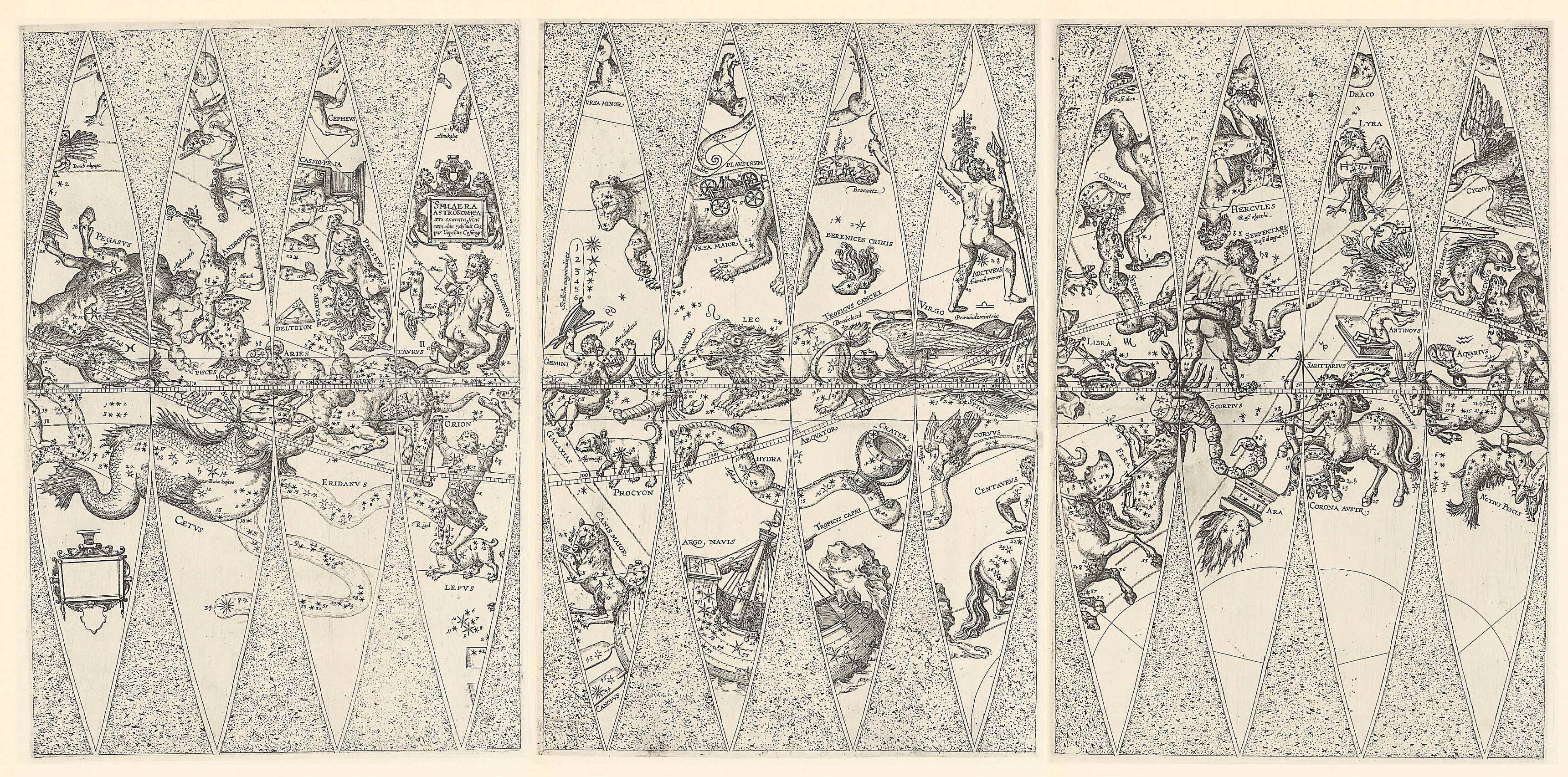
Copper engraved, Ø sphere
Above Auriga [lon 75°, lat 60°] is an inscription in a cartouche with a
coat of arms on top and two lions at the sides: SPHAERA / ASTRONOMICA / aeri
exarata, sicut / eam olim exhibuit Cas/par Vopelius Cosmogr. South of the
tail of Cetus [lon 345°, lat −60°]
is an empty cartouche consisting of a rectangular field with decorations around
it.
Cartography: The same as Vopel 1536
(G1).
Astronomical notes: Almost the same
as Vopel 1536 (G1), but the name of the constellation
Iconographic features: Almost the same as Vopel 1536 (G1). The Pleiades in Taurus are illustrated by four instead of six tiny female heads.
Copper engraved, Ø sphere
Above Auriga [lon 75°, lat 60°] is an empty cartouche with a coat of arms
on top and two lions at the sides. South of the tail of Cetus [lon 345°, lat −60°]
is another empty cartouche, consisting of a rectangular field with decorations
around it.
Cartography: The same as Vopel 1536
(G1).
Astronomical notes: Almost the same
as that of Vopel 1536 (G1). The title of the magnitude table in front of Ursa
Maior is missing. Five constellation names are missing (Cygnus, Cassiopeia,
Delphinus, Navis, Hydra), and five constellation names have a variant spelling: CAEPHE(VS),
LIRA, ERIOTONIVS, CANIS MINOR, NOTIVS PISCIS. The image of Antinous is drawn
but not labelled. Only three subgroups are labelled: C. MEDVSAE (Per), VERGILIE
(Tau) and VRNA (Aqr). Many stars are missing and only one star name is
engraved: MARKAB (α Peg).
Iconographic features: Almost the same as Vopel 1536 (G1). The Kids in Auriga are absent, and the Pleiades in Taurus are illustrated by five instead of six tiny female heads.
Nota 101 e 102 (a cura di Atlascoelestis)
101. Sotheby's, Catalogue
Natural History, Travel, Atlases and Maps (
102. Van der Krogt, ‘The globe-gores in the Nicolai-Collection’ (see note 101), 112–13, no. 20.
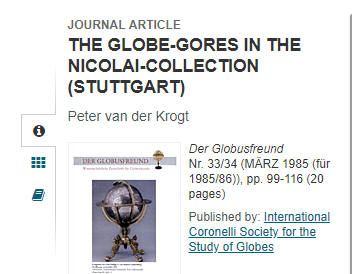
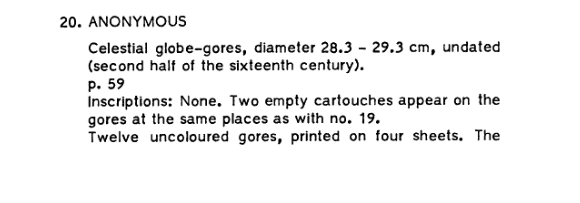
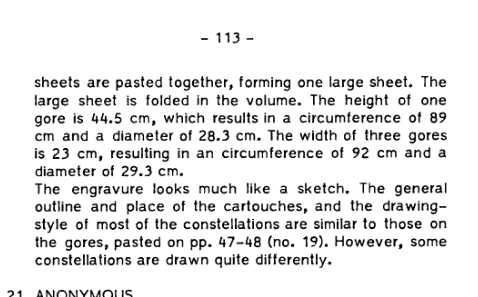
Woodcut,
Ø sphere
There is an empty cartouche south of the tail of Cetus [lon 345°, lat −60°]
consisting of a rectangular field with decorations around it.
Cartography: Almost the same as
Vopel 1536 (G1). The tropics are labelled TROPICVS CANCRI and TROPICVS
CAPRICOR[NVS]. The polar circles are labelled CIRCVLVS ARCTICVS
and CIRCVLVS ANTARCTICVS. Around the South Pole are two incomplete labels:
one for the winter solstitial colure: SOLSTITIO and another for the
vernal equinoctial colure: COLVRVS. Outside the constellations most
circles are covered by paint.
Astronomical notes: Almost the same
as that of Vopel 1536 (G1). The title of the magnitude table in front of Ursa
Maior is missing (but it might be covered by paint). Missing are two
constellation names (Ursa Minor and Cancer) and the name of the Hyades in Taurus.
Only five stars are labelled: ARCTVRVS (α Boo), SPICA (α
Vir), CANOPVS (α Car), HIRCVS (α Aur) and ACARNAR
(θ Eri).
Iconographic features: Almost the
same as Vopel 1536 (G1), but here one finds in addition the image of a young man
representing Phaeton at the end of Eridanus.
M1.
A
PAIR OF CELESTIAL MAPS included on the world map by Jeronimo de Girava (
Vedi: http://www.atlascoelestis.com/Girava%201556.htm, nota di Atlascoelestis
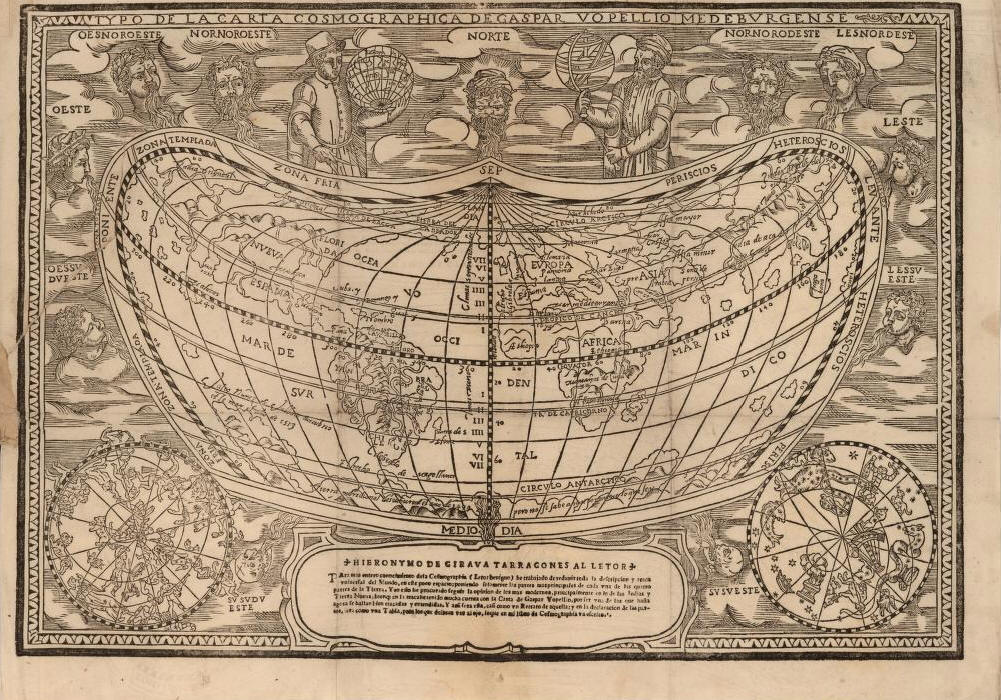
1)
Northern hemisphere in the left lower corner of the world map.
A)
Cartography: Polar stereographic projection: from the north ecliptic pole to
south of the ecliptic to include the zodiacal constellations. Coordinates:
circles of latitude every 30°. The ecliptic is graduated [twelve times 0°–30°;
not numbered, division 3°]. The part of equator north of the ecliptic is drawn.
The north polar circle, the Tropic of Cancer and the equinoctial colures are
drawn but not labelled.
B)
Astronomical notes: All northern and zodiacal Ptolemaic constellations are drawn.
There are no labels.
C)
Iconographic features: The style follows that of Dürer but with some
differences: Lyra is a headless bird (note that the orientation of the string
instrument differs from that on Vopel's globe by being placed vertically over
the body, as on Dürer's map); Boötes is presented with lance, club and hunting
dogs; one of the Gemini has a lyre or similar instrument without bow. In
addition there are images of Antinous and Coma Berenices comprising the unformed
stars belonging to
2)
Southern hemisphere in the right lower corner of the world map.
A)
Cartography: Polar stereographic projection: from the south ecliptic pole to the
ecliptic. Coordinates: circles of latitude every 30°. The ecliptic is graduated
[twelve times 0°–30°; not numbered, division 3°]. The part of equator south
of the ecliptic is drawn. The south polar circle, the Tropic of Capricorn and
the colures are drawn but not labelled.
B)
Astronomical notes: All southern Ptolemaic constellations are drawn. There are
no labels.
C)
Iconographic features: A cloud of smoke rises from Ara and a swimming maiden is
at the end of Eridanus.
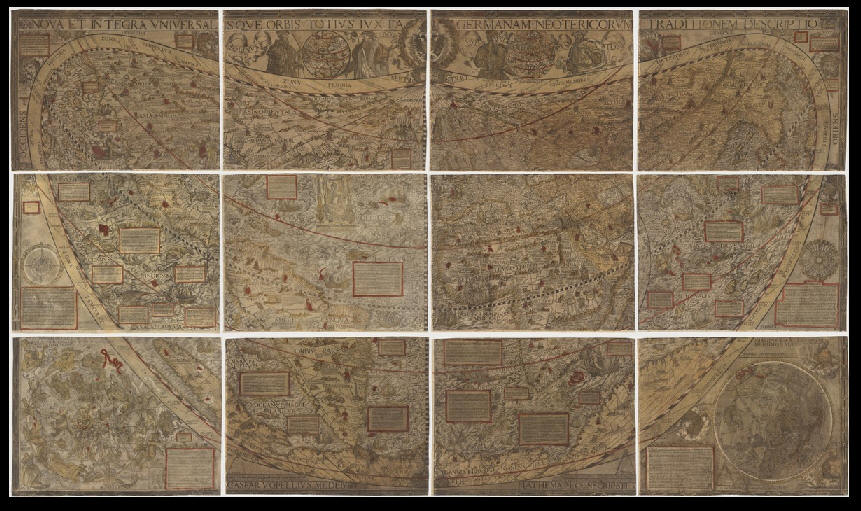
1)
Northern hemisphere in the lower left corner of the world map entitled: IMAGINES
CELI SEPTEN / TRIONALES CVM DVODECIM / IMAGINIBVS ZODIACI. Outside the map
are two figures. One, labelled PTOLOME / VS / AEGYP / TIVS, wears a top
hat and holds a pair of dividers with a celestial globe in his left hand. The
other figure, labelled AZOPHI / ARABVS, wears a turban and holds a
celestial globe in both hands.
A)
Cartography: Polar stereographic projection from the north ecliptic pole to
south of the ecliptic to include the zodiacal constellations. Language: Latin
and Greek. Coordinates: circles of latitude every 30°. The ecliptic is
graduated [twelve times 0°–30°; numbered every 5°, division 1°]. The names
and symbols of the zodiacal signs are absent. The part of equator north of the
ecliptic is drawn. It is not graduated and not labelled. The north
equatorial pole is labelled Polus mundi Arcticus. The north polar circle
is drawn and labelled: Circ Arcticus. The Tropic of Cancer is drawn and
labelled: Tropicus Cancri. The equinoctial colures (not labelled) are
drawn from the vernal to the autumnal equinox passing through the north
equatorial pole. The solstitial colures (labelled Colurus Solsticiorum)
coincide with the circle of latitude passing through the north ecliptic and
equatorial pole.
B)
Astronomical notes: All northern and zodiacal Ptolemaic constellations are drawn,
and all but one (Draco) are labelled: VRSA MIN / Greek name; VRSA MAIOR /
Helice; CEPHEVS; BOOTES / Greek name; CORONA; HERCVLES / Greek name; LYRA,
AVIS / Greek name; CASSIOPEIA; PERSEVS; ERICHTHONIVS / Auriga; OPHIVCH /
serpentarius; ANGVIS; TELVM; AQVILA; DELPHINVS; EQVICVLVS; PEGASVS; ANDROMEDA;
DELTOTON; ARIES / Greek name; TAVRVS / Greek name; GEMINI; CANCER
/ Greek name; LEO; VIRGO / Greek name; LIBRA / Greek name; SCORPIO
/ Greek name; SAGITARIVS / Greek name; CAPRICORNVS / Greek
name; AQVARIVS / Greek name; PISCES / Greek name. Also the groups
of unformed stars belonging to
C)
The stars are presented by six different marks to indicate their brightness or
magnitude. Outside the map, below Sagittarius, is a table labelled Stellarum
magnitudines, with magnitudes from 1–6, and alongside these the number of
stars within each magnitude class [15, 45, 208, 474, 217, 49]. The stars of the
Pleiades are missing. There are planetary symbols for astrological associations,
and many stars are labelled: Abrachaleus / Herculis (β
Gem), Aldebaran (α
Tau), Alhaior (α
Aur), Alioth (ϵ
UMa), Alkair (α
Aql), Alkor/ Equitator (near ζ
UMa), Alrucuba (α
UMi), Anhelar / Apolinis (α
Gem), Arcturus / Azimech aramer / Alramech (α Boo), Benenatz (η UMa), Capra (α Aur), Deneb algedi (δ Cap), Denebeneced (β Leo), Dubhe (α UMa), Fomahant (α PsA), Makab (α Peg), Mirach (β And), Propus (η Gem), Rass Alangue (α Oph), Regulus / Cabalezet / Greek name (α
Leo), Rasdagel (β
Per), Scheat (δ
Aqr), SPICA / Azimech / Greek name (α
Vir), Stella polaris (α
UMi), Vindemiator (ϵ
Vir), Greek name for Antares (α
Sco).
D)
Iconographic features: The style follows that of Dürer but with some
differences: Lyra is a headless bird (note that the orientation of the string
instrument differs from that on Vopel's globe by being being placed vertically
over the body, as on Dürer's map); Boötes is presented with lance, sickle and
hunting dogs, and a goat is eating leaves from a vine above his head; one of the
Gemini has a lyre or similar instrument without bow. In addition there are
images of Antinous and Coma Berenices comprising the unformed stars belonging to
2)
Southern hemisphere in the lower right corner of the world map entitled: IMAGINES
CELLI / MERIDIONALIS. Outside the map are two figures. One, labelled M.
MANILIVS / OMANVS [sic], wears a headband and holds a celestial globe in his
left hand. The other, labelled ARATVS / CILIX, wears a hood and has a
celestial globe on front of him.
A)
Cartography: Polar stereographic projection: from the south ecliptic pole to the
ecliptic. Language: Latin and Greek. Coordinates: circles of latitude every 30°.
The ecliptic is graduated [twelve times 0°–30°; numbered every 5°, division
1°]. The south ecliptic pole is labelled: Polus Zodiaci. The part of
equator south of the ecliptic is drawn. It is labelled: PARS CIRC AEQVINOC
but it is not graduated. The south equatorial pole is labelled: POLVS mundi
antarct. The south polar circle is drawn and labelled: CIRC. ANTARCTI.
The Tropic of Capricorn is drawn and labelled: TROPICVS CAPRICOR. The
equinoctial colures, labelled COLVRVS AEQVINOCTIORVM, are drawn from the
autumnal to the vernal equinox passing through the south equatorial pole. The
solstitial colures, labelled COLVRVS SOLSTICIORVM, coincide with the
circle of latitude passing through the south ecliptic and equatorial pole. Below
the title is a nonlinear latitude scale, labelled: REGVLA LATITVDINVM
STELLARVM [0°–90°; numbered every 10°, division 1°].
B)
Astronomical notes: All southern Ptolemaic constellations are drawn and labelled:
CETVS / Balena Pristis Leo marinus, ORION, ERIDANVS, LEPVS / Greek name, CANIS
MAIO, CANIS MI. / Greek name, ARGO, HYDRA, CRATER, CORVVS, CENTAV. /
Phyllirides Chiron, FERA / Greek name, ARA/ Greek name,
C)
The stars are presented by six different marks to indicate their brightness or
magnitude. There are planetary symbols for astrological associations, and many
stars are labelled: Acarnar (θ
Eri), Aldebaran / Greek name spelled Λαμπαδιας
(α Tau), Algomeysa
(α CMi), Algorab
(γ Crv), Alphard
(α Hya), Angetenar
(τ Eri), Bata
Kaitos (ζ Cet),
Bedelgeuze (α
Ori), CANOP (α
Car), Deneb algedi (δ
Cap), Deneb Kaytos (β
Cet), Fomahant (α
PsA), Menkar (α
Cet), Rigel / Algebar (β
Ori), the Greek name for Antares (α
Sco).
D) Iconographic features: The style follows Dürer but with two deviations: a cloud of smoke rises from Ara and a swimming maiden is at the end of Eridanus.
M3.
A
PAIR OF CELESTIAL MAPS included on the world map by Matteo Pagano (
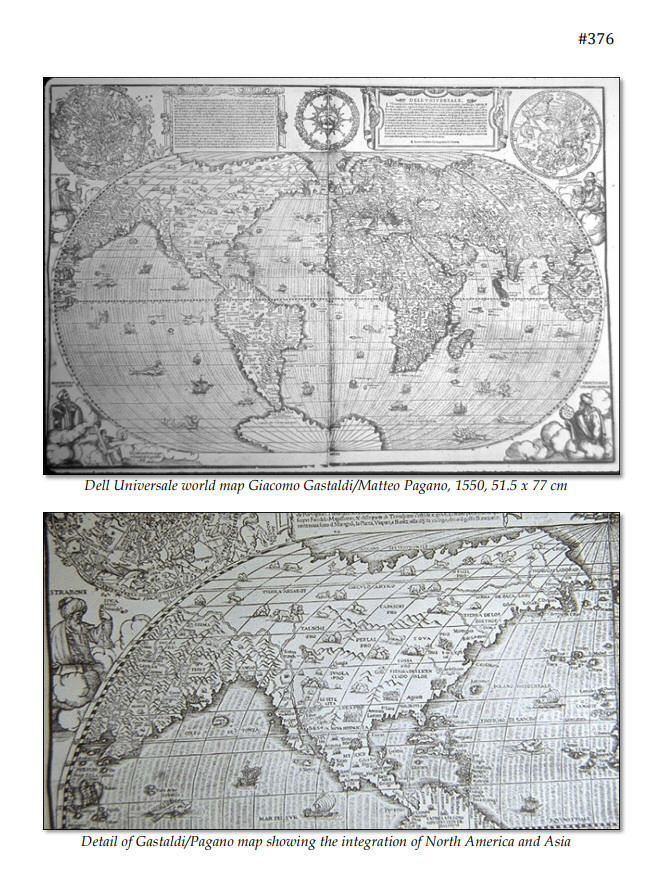
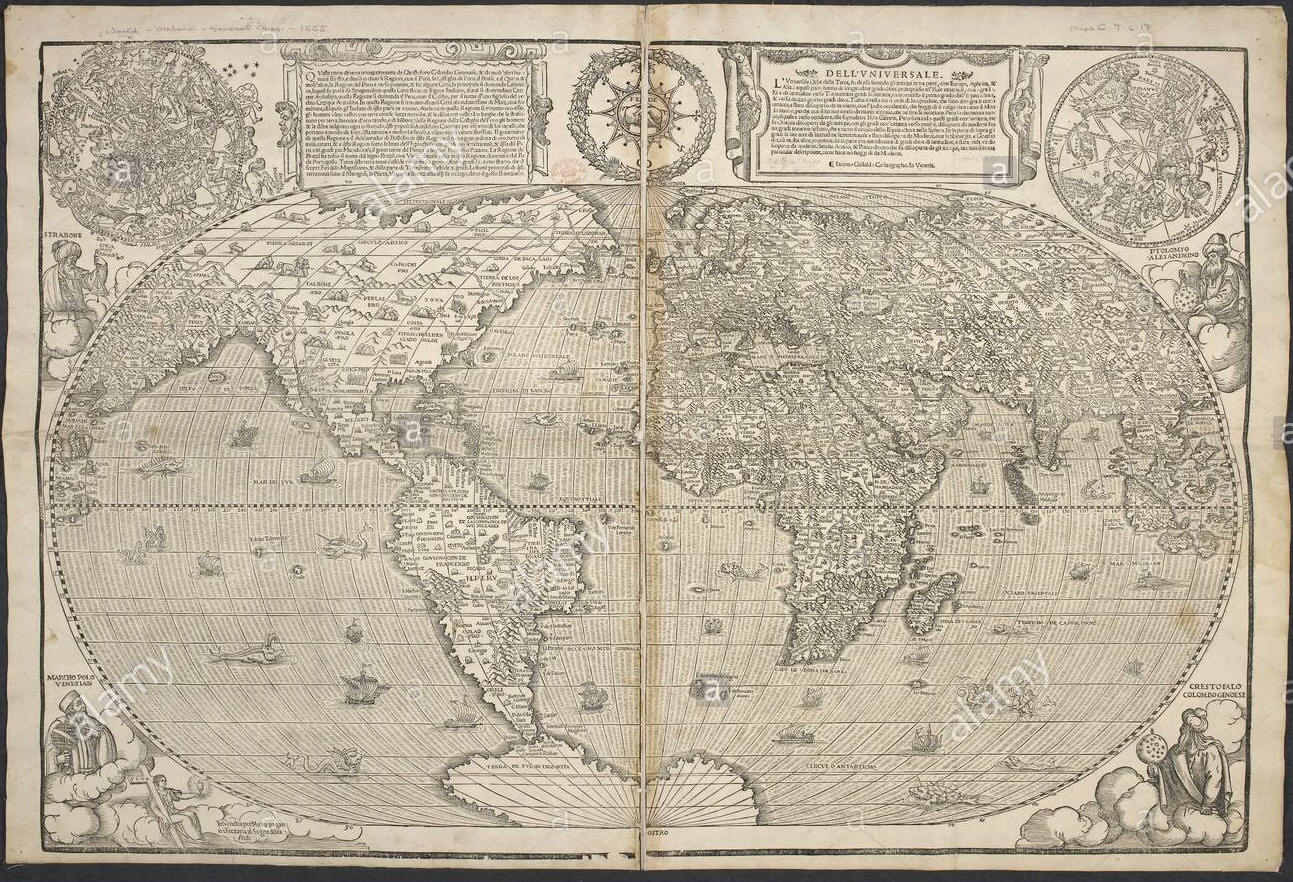
2) in

Cosmographia Universalis et Exactissima iuxta postremam neotericorum traditio[n]em. A Iacobo Castaldio nonnullisque aliis huius disciplinæ peritissimis nunc [pr]imum revisa ac infinitis fere in locis correcta et locupletata.
Author: Giacomo di Gastaldi
Contributor: Paolo
Forlani;
Matteo Pagano
Subjects: World - -- Maps and charts -- 1561
Publication Details: [Venice?] : [Matteo Pagano], [ca. 1561]
Language: Latin
Description: Contents: A woodcut map of the world on an elliptical projection; marginal decoration includes portraits of Ptolemy and Strabo, and the celestial and terrestrial hemispheres. On the sheet covering the North Atlantic is a depiction of Philip II of Spain in which the initials 'P.F.D.' are cut, which may be identifiable as those of Paolo Forlani, an engraver in Venice in the 1560s.
Identifier: System number: 005015603
Notes: The date of the map
is assumed from the publication by Matteo Pagano of a booklet by Gastaldi, “La
Universale Descrittione del Mondo” (1561), in which a similar world map is
described.
The seven cartouches are left blank.
Physical Description: 1 map on 9 sheets ; sheets 45 x 40 cm.
Holdings Notes: Cartographic Items Maps R.17.a.9. [A photocopy]
Shelfmark(s): Cartographic
Items Maps C.18.n.1.
Cartographic Items Maps R.17.a.9.
UIN: BLL01005015603
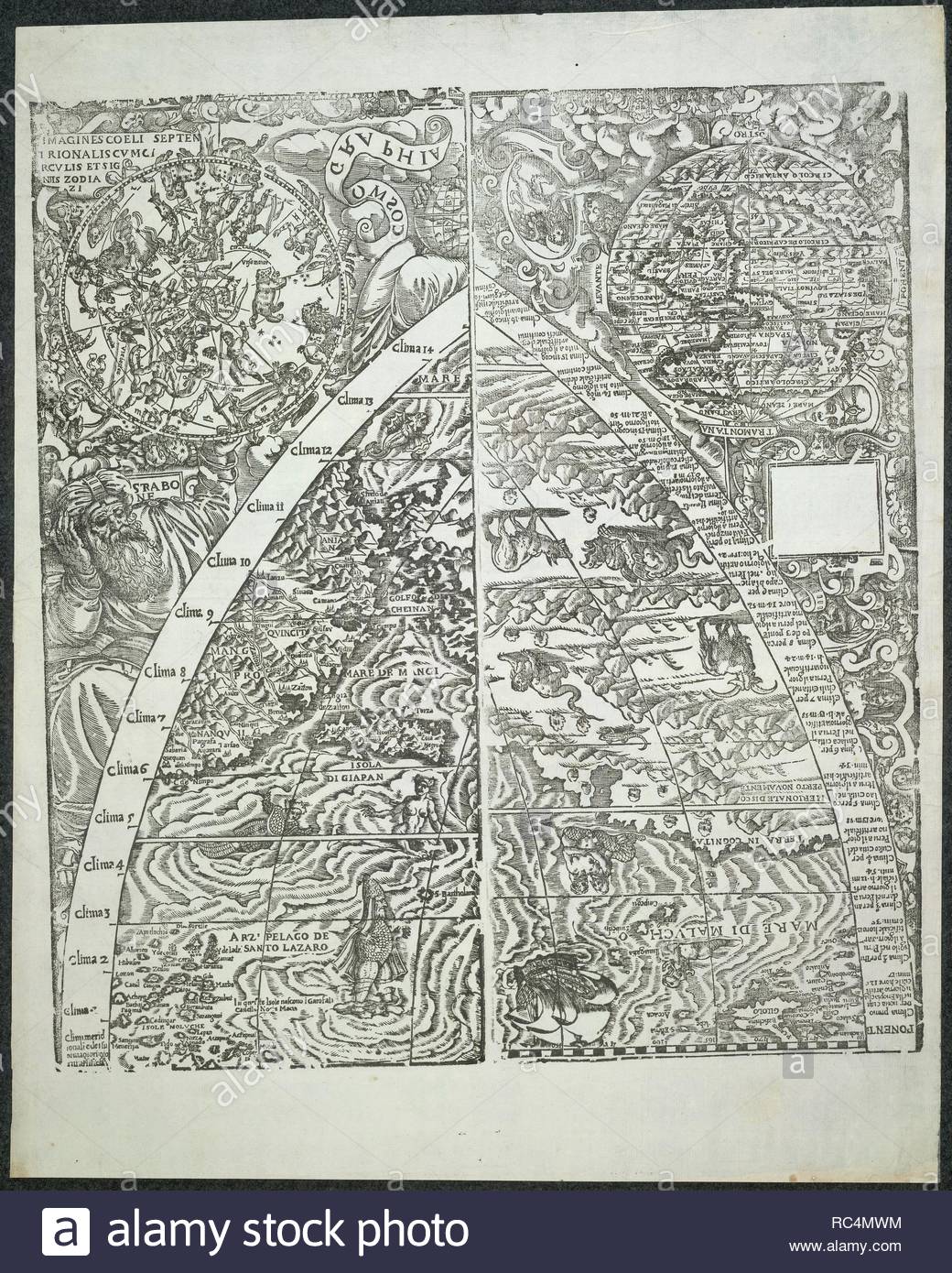
1)
Northern hemisphere in the upper left corner of the world map.
A)
Cartography: Almost the same as Valvassore 1558 (M2). The north equatorial pole
is labelled Polus mundi Arturus [sic] and the north polar circle Circ
Articus [sic] .
B)
Astronomical notes: Almost the same as Valvassore 1558 (M2). There is no
magnitude table, and the text on
C)
Iconographic features: The same as Valvassore 1558 (M2).
2)
Southern hemisphere in the upper right corner of the world map.
A)
Cartography: Almost the same as Valvassore 1558 (M2). There is no latitude
scale.
B)
Astronomical notes: Almost the same as Valvassore 1558 (M2). The Greek name of
Lepus and the label Balena Pristis Leo marinus for Cetus are left out.
Two constellations have a variant spelling: CANIS MAIOR and HIDRA.
The name of one subgroup is missing (Nodvs coelestis), and one is spelled
differently: Scorpii stelle (Sco). One star name has a variant spelling: Denecb
Kaytos (β Cet).
C)
Iconographic features: The same as Valvassore 1558 (M2).
M4.
A
PAIR OF CELESTIAL MAPS included on the world map by Bernaard van den Putte (
V
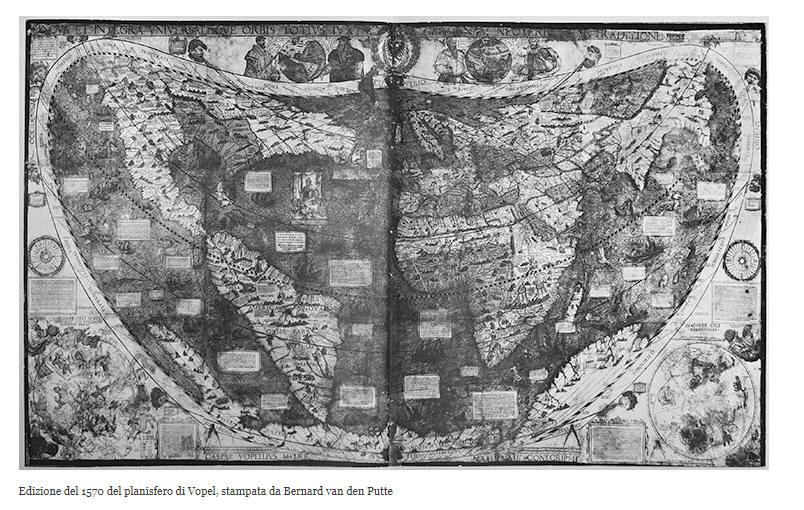
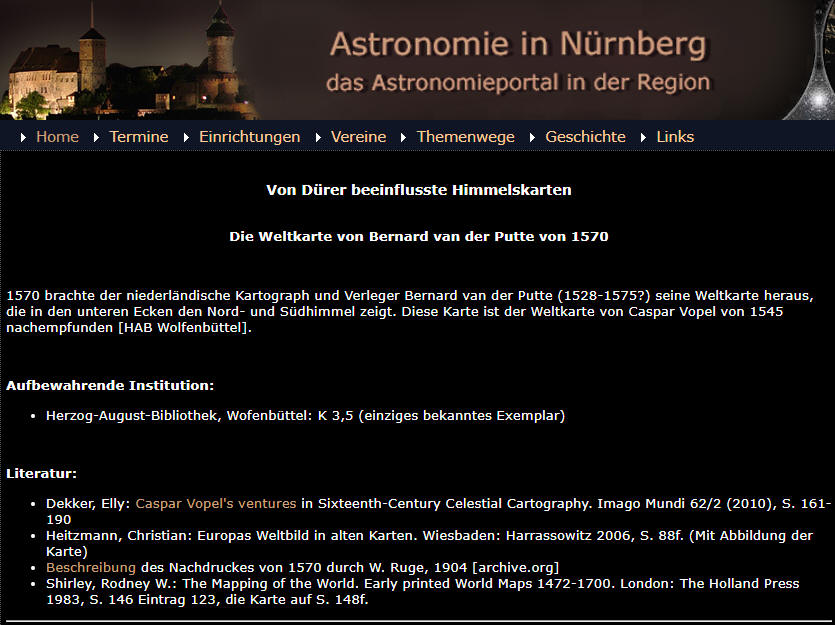

https://archive.org/stream/nachrichtenvond07klasgoog#page/n25/mode/2up
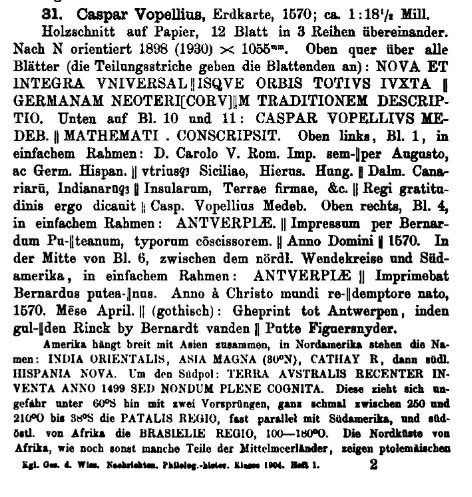
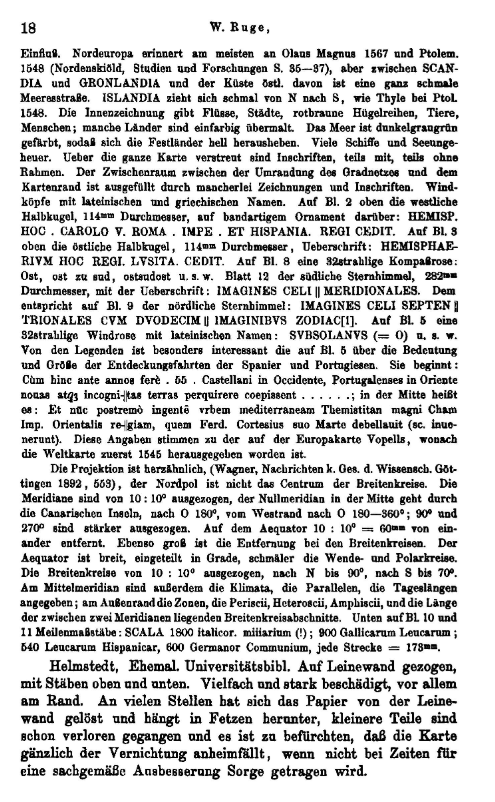
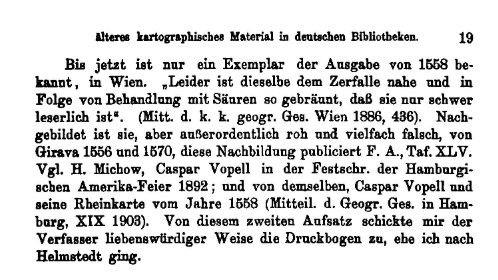
1)
Northern hemisphere in the lower left corner of the world map entitled: IMAGINES
CELI SEPTEN / TRIONALES CVM DVODECIM / IMAGINIBVS ZODIAC. Outside the map
are two figures. One, labelled PTOLOMA[EVS] / AEGYPTIVS, wears a top hat
and has a pair of dividers with a celestial globe. The other, labelled AZOPHI
/ ARABVS, wears a turban and holds a celestial globe in his hands.
A)
Cartography: The same as Valvassore 1558 (M2).
B)
Astronomical notes: Almost the same as Valvassore 1558 (M2). There is a Greek
name for Gemini, but the Greek name for Taurus is missing. Variant spellings of
constellation names: DECTOTON, SAGITTA. There are two additional names
for subgroups: Hædi (Aur) and Vergiliæ. The four Ptolemaic
Pleiades stars and two extra, non-Ptolemaic stars are also marked. Variant (correct)
spellings of star names: Markab (α
Peg); Denebeleced (β
Leo). The area below the name SPICA (α
Vir) is damaged.
C)
Iconographic features: Almost the same as Valvassore 1558 (M2). Lyra is now a
bird with a head (note that the orientation of the string instrument deviates
from that on Vopel's globe by being drawn vertically along its body as on Dürer's
map).
2)
Southern hemisphere in the lower right corner of the world map, entitled: IMAGINES
CELI / MERIDIONALES. Outside the map are two figures. One, labelled M.
MANILIVS / ROMANVS, wears a headband and holds a celestial globe in his left
hand. The other, labelled ARATVS / CILIX, wears a hood and has a
celestial globe on front of him.
A)
Cartography: The same as Valvassore 1558 (M2).
B)
Astronomical notes: Almost the same as Valvassore 1558 (M2). There is a variant
spelling for Navis: ARCO, and two additional star names: Bellatrix
(γ Ori) and Alhabor
(α CMa).
C)
Iconographic features: The same as Valvassore 1558 (M2).
M5. A
PAIR OF CELESTIAL MAPS by an anonymous maker. Woodcut, 28.5 ×
vedi
http://www.atlascoelestis.com/Anon%20gall%20500.htm

1)
Northern hemisphere
A)
Cartography: Polar stereographic projection: from the north ecliptic pole to
south of the ecliptic to include the zodiacal constellations. Language: Latin.
Coordinates: circles of latitude every 30°. The ecliptic is graduated [twelve
times 0°–30°; not numbered, division 10°, subdivision 1°], and the symbols
of the zodiacal signs are marked. The part of equator north of the ecliptic is
drawn. It is graduated [not numbered, division 10°, subdivision 1°] and
labelled AEQVINOCTIALIS. The north polar circle and the Tropic of Cancer
are labelled respectively: Circulus Acrticus and TROPICVS CANCRI.
The colures are not labelled. The north equatorial pole is labelled but
difficult to read.
B)
Astronomical notes: All northern and zodiacal Ptolemaic constellations are drawn,
and all but one (Serpens) are labelled: Vrsa minor, Vrsa maior, Draco,
Cepheus, Bootes, Corona, Hercules, Lyra, Cygnus, Cassiopeia, Perseus,
Erichthonius, Ophiuchus, Sagitta, Aquila, Delphin, Equiculus, Pegasus,
Andromeda, Deltoton, Aries, Taurus, Gemini, Cancer, Leo, Virgo, Libra, Scorpius,
Sagittarius, Capricornus, Aquarius, Pisces. Also the groups of unformed
stars belonging to
C)
Iconographic features: Lyra is represented by a bird with a head (note that the
orientation of the string instrument differs from that on Vopel's globe by being
being placed vertically over the body, as on Dürer's map), Boötes holds a
lance in his right hand, and the Gemini have no attributes. In addition there
are images of Antinous and Coma Berenices comprising the unformed stars
belonging to
2)
Southern hemisphere
A) Cartography: Polar stereographic projection: from the south ecliptic pole to the ecliptic. Language: Latin. Coordinates: circles of latitude every 30°. The ecliptic is graduated [twelve times 0°–30°; numbered every 10°, division 1°]. The symbols of the zodiacal signs are marked. The part of equator south of the ecliptic is drawn. It is graduated [not numbered, division 10°, subdivision 1°]. The south polar circle and the Tropic of Capricorn are labelled respectively: Circulus Antarcticus. and TROPICVS CAPRICORNI. The colures and the south ecliptic pole are not labelled. The south equatorial pole is labelled but difficult to read. There is no latitude scale.
B)
Astronomical notes: All southern Ptolemaic constellations are drawn and labelled:
Cetus, Orion, Eridanus, Lepus, Sirius, Canis minor, Argo navis, Hidra,
Crater, Corvus, Centaurus, Fera, Ara,
C)
Iconographic features: The same as Valvassore 1558 (M2).
1. Herbert Koch, Aus der
Geschichte der Familie Vopelius: familiengeschichtliche Blätter herausgegeben
von Bernhard Vopelius,
2. At the
3. Ernst Zinner, Deutsche und
niederländische astronomische Instrumente des 11–-18. Jahrhunderts (1st
ed., 1956; 2nd enlarged ed., 1967; reprint of 2nd ed.,
4. Robert W. Karrow, Mapmakers
of the Sixteenth Century and Their Maps: Bio-bibliographies of the Cartographers
of Abraham Ortelius, 1570 (Chicago, Speculum Orbis Press, 1993), 558–67.
5. Paul Kunitzsch, Der Almagest.
Die Syntaxis Mathematica des Claudius Ptolemäus in arabisch-lateinischer Überlieferung
(Wiesbaden, Otto Harrossowitz, 1974), 167–68, has a table listing each
constellation with the Greek name, the modern Latin name and the conventional
abbreviations. For a concordance between the two ways of identifying stars, see
Paul Kunitzsch, Claudius Ptolemäus: Der Sternkatalog des Almagest. Die
arabisch-mittelalterliche Tradition. Vol. III: Gesamtkonkordanz der
Sternkoordinaten (Wiesbaden, Otto Harrossowitz, 1991), 187–94.
6. Leonard Korth, ‘Die Kölner
Globen des Kaspar Vopelius von Medebach (1511–1561)’, Zeitschrift für
vaterländische Geschichte und Alterthumskunde 42 (1884): 169–78.
7. Korth, ‘Die Kölner Globen’
(see note 6), 172; Koch, Caspar Vopelius Kartograph in Köln 1511–1561
(see note 1), 9; Karrow, Mapmakers (see note 4), 558.
10. For the Arabic-Latin tradition
of the Ptolemaic star catalogue, see Kunitzsch, Der Almagest (see note
5), where the name Almagest is discussed on 115–25. The first printed
edition of the star catalogue is Almagestum Cl. Ptolemei Pheludiensis
Alexandrini Astronomorum principis (
11. Paul Kunitzsch, ‘The star
catalogue commonly appended to the Alfonsine Tables’, Journal for the
History of Astronomy 17 (1987): 89–98. Reprinted in Paul Kunitzsch, The
Arabs and the Stars (Northampton, Variorum Reprints, 1989), ch. 22. The editio
princeps of the Alfonsine Tables appeared in
12. For the 1515 edition of the
Almagest, see note 10. Kunitzsch, Der Almagest (see note 5), 185–86. In
the Middle Ages and Renaissance, Vultur volans was also used as a name of the
brightest star of
13. The name ‘Altair’ developed
during the Middle Ages and is known in many spellings, see Paul Kunitzsch, Arabische
Sternamen in Europe (Wiesbaden, Otto Harrossowitz, 1959), 81–82 and
138–39. The name Alkair occurs in star tables from the first decades of the
15th century, see Paul Kunitzsch, Typen von Sternverzeichnissen in
astronomischen Handschriften des zehnten bis vierzehnten Jahrhunderts (Wiesbaden,
Otto Harrossowitz, 1966), 114, Type XVII, no. 36.
14. Johannes Stöffler, Elucidatio
fabricae ususque astrolabii (Oppenheym, Jacobus Köbel, 1512–1513). This
treatise was reprinted many times in the 16th century. The star α Aql is
listed in Stöffler's star tables as both Vultur volans and Alkayr.
15.
Alfonsi Hispaniarum Regis Tabule (Venice, Luca Antonio Junta, 1524),
106r–107v. Kunitzsch, ‘The star
catalogue commonly appended to the Alfonsine Tables’ (see note 11), 93. Paul
Kunitzsch has told me that the information in this survey, constructed by L.
Gauricus, is taken from the Quadripartitum, the Latin translation of
Ptolemy's Tetrabiblos made by Plato Tiburtinus from the Arabic. Ptolemy
speaks of ‘the star of Apollo’ and ‘the star of Hercules’, see Ptolemy, Tetrabiblos,
ed. and transl. F. E. Robbins; Loeb Classical Library (Cambridge, Mass., Harvard
University Press, 1940, reprint 1980), I.9.
16. Kunitzsch, Der Almagest
(see note 5), 255, no. 212. The name Antinous occurs in the Arabic translation
of Ptolemy's Syntaxis mathematica made during the reign of Caliph al-Ma'mūn
(813–833) of Bagdad by al-![]() ajjāj
ibn Yūsuf ibn Ma
ajjāj
ibn Yūsuf ibn Ma![]() ar,
but Gerard of Cremona predominantly followed the Arabic version made around
879–890 by the Bagdad physician Is
ar,
but Gerard of Cremona predominantly followed the Arabic version made around
879–890 by the Bagdad physician Is![]() āq
ibn
āq
ibn
![]() unayn,
who did not mention the name of Antinous, apparently because the name was
missing in the Greek original used by him (Paul Kunitzsch, private communication).
unayn,
who did not mention the name of Antinous, apparently because the name was
missing in the Greek original used by him (Paul Kunitzsch, private communication).
17. John Monfasani, George of
18. Georgio Valla, De expetendis
et fugiendis rebus (
19. Dürer's maps have frequently
been discussed in the literature; one of the best is that of W. Voss, ‘Eine
Himmelskarte vom Jahre 1503 mit den Wahrzeichen des Wiener Poetenkollegiums als
Vorlage Albrecht Dürers’, Jahrbuch der preussischen Kunstsammlungen 64
(1943): 89–150.
20. Apian's planisphere of 1536 is
described by Deborah J. Warner, The Sky Explored: Celestial Cartography
1500–1800 (New York, Alan R. Liss; Amsterdam, Theatrum Orbis Terrarum Ltd.,
1979), 10; and reproduced in full in Paul Kunitzsch, Peter Apian und Azophi:
Arabische Sternbilder in Ingolstadt im frühen 16. Jahrhundert (Munich,
Verlag der Bayerischen Akademie der Wissenschaften, 1986).
21. Gemma Frisius's globe is
described in Dekker, Globes at
23. Hyginus, Poeticon
Astronomicon (see note 22), fol. m iiii. The text of the legend on Bernaard
van den Putte's world map (
24. The bibliography for Aratus's
original Greek poem is extensive. The reader is directed to recent annotated
editions and translations of the text: Aratos, Phainomena. Sternbilder und
Wetterzeichen, ed. and transl. M. Erren (Munich, Heimeran, 1971); Aratus, Phaenomena,
ed. and transl. D. Kidd (Cambridge, Cambridge University Press, 1997); Aratos, Phénomènes,
ed. and transl. J. Martin, 2 vols (Paris, Les Belles Lettres, 1998). A
discussion of all descriptive catalogue traditions is presented in Elly Dekker.
‘The provenance of the stars in the Leiden Aratea Picture Book’, Journal
of the Warburg and Courtauld Institutes (
25. Ulrike Bauer, Der Liber
Introductorius des Michael Scotus in der Abschrift Clm 10268 der Bayerischen
Staatsbibliothek München: Ein illustrierter astronomisch-astrologischer Codex
aus
26. The illustrations of Hyginus's
1482 edition are discussed in Warner, The Sky Explored (see note 20),
269. She concludes that ‘most, if not all, of the constellation figures in
these books [of Hyginus] were closely patterned after the figures printed by
Ratdolt’. The Scot illustrations have been reprinted in Theony Condos, Star
Myths of the Greeks and Romans: A Sourcebook Containing the Constellations of
Pseudo-Eratosthenes and the Poetic Astronomy of Hyginus (Grand Rapids,
Mich., Phanes Press, 1997).
27. Bauer, Der Liber
Introductorius (see note 25), 53–55.
28. Warner, The Sky Explored
(see note 20), 74, discusses the variant numbering of the stars of Andromeda
used on the Dürer maps and its forerunners. Note that this numbering is not
used by Vopel.
29. Vopel's drawings were
reproduced by the
30. Zofia Ameisenowa, The Globe
of Martin Bylica of Olkusz and Celestial Maps in the East and in the West,
transl. by Andrzej Potocki (
31. Dekker, Globes at Greenwich
(see note 3), 87–91 and 341–42 for Gemma Frisius's globe; 91–95 and
412–13 for Mercator's globe. The difference between the astrological
information on these two globes is discussed in Annelies van Gijsen, ‘Mercator
and astrology’, in Gerardus Mercator Rupelmundanus, ed. Marcel Watelet
(Antwerp, Mercatorfonds Paribas, 1994). A French edition of this book appeared
as Gerard Mercator, cosmographe: le temps et l'espace, ed. Marcel Watelet
(Antwerp, Mercatorfonds Paribas, 1994).
33. Peter van der Krogt, Globi
Neerlandici. The Production of Globes in the
34. Dekker, Globes at Greenwich
(see note 3), Ch. 7, 69–74.
35. Karrow, Mapmakers (see
note 4), 560–62. Ruge, ‘Die Weltkarte des Kölner Kartographen Caspar Vopell’
(see note 23), 392–405.
36. Private communication from
Peter Meurer. Günter Schilder, Monumenta Cartographica Neerlandica II (Alphen
aan den Rijn, Uitgeverij ‘Canaletto’, 1987), 26, mentions editions of 1549
and 1552.
37. Short descriptions of maps M1
and M2 are given in Warner, The Sky Explored (see note 20), 262.
38. Kunitzsch, Peter Apian und
Azophi (see note 20), 53–56, Exkurs III.
39. K. Lippincott, ‘The problem
with being a minor deity: the story of Eridanus’, in Images of the Pagan
Gods. Papers of a Conference in Memory of Jean Seznec, eds R. Duits and F.
Quiviger; Warburg Institute Colloquia 14 (
40. Dekker, Globes at Greenwich
(see note 3), 69–74 and 91.
41. Cornelis Koeman, Günter
Schilder, Marco van Egmond and Peter van der Krogt, ‘Commercial cartography
and map production in the Low Countries, 1500–ca.
42. Pagano did not copy the titles
of Valvassore's maps. Of the four astronomers in the corners of Valvassore's
maps, Pagano kept only PTOLOMEO ALESANDRINO. The three others were
replaced by geographers located in the corners of the world map itself, see
Rodney W. Shirley, The Mapping of the World: Early Printed World Maps
1472–1700 (London, Holland Press Limited, 1984; reprinted with corrections,
1987), 101, Plate 76.
43. They are referred to briefly by
Anna Friedman Herlihy, ‘Renaissance star charts’, in Woodward, Cartography
in the European Renaissance (see note 41), 1: 99–122, esp. 115.
44. See, for example, the world
maps by Guillaume Postel (1581) and Petrus Plancius (1592) in Shirley, The
Mapping of the World (see note 42), 166–67, Plate 122, and 199–202,
Plate 148.
45. The six little female heads
drawn by Vopel are a reminder of Hyginus's claim that only six stars of the
Pleiades are visible (see Hygin, Astronomie (note 22), II.21). In
medieval illustrated manuscripts the Pleiades are usually represented by the
busts of seven females, never six. Medieval images of the Asses drawn on the
shell of Cancer are, for example, seen in the illustrations in Patrick McGurk,
‘Germanici Caesaris Aratea cum Scholiis: a new illustrated witness from
Wales’, The National Library of Wales Journal 18 (1973): 197–216, esp.
Plate I (A) and Plate II (B). In medieval illustrated manuscripts the Kids are a
regular feature of the iconography of Auriga. For an example, see Ranee
Katzenstein and Emilie Savage-Smith, The Leiden Aratea: Ancient
Constellations in a Medieval Manuscript (Malibu, The J. Paul Getty Museum,
1988), 23. Their mythological significance is explained in Hygin, Astronomie
(see note 22), II.13.
46. The identification of the
Gemini as Apollo and Hercules is also one of the options mentioned by Hyginus,
see Hygin, Astronomie (see note 22), II.22.
47. Eric M. Moorman and Wilfried
Uitterhoeve, Lexikon der antiken Gestalten: mit ihrem Fortleben in Kunst,
Dichting und Musik, transl. Marinus Pütz (Stuttgart, Kröner, 1995).
48. Dekker, ‘Globes in
Renaissance Europe’, in Woodward, Cartography in the European Renaissance
(see note 41), 1: 135–73, esp. 144–45, fig. 6.6.
For a reproduction of the Gemini on Schöner's globe of c.1533, see Elly
Dekker and Peter van der Krogt, Globes from the Western World (London,
Zwemmer, 1993), 29, Plate 5.
49. Hygin, Astronomie (see
note 22), II.4. The translation is from Condos, Star Myths (see note 26),
56. The name Icarus is often used synonymously with Icarius, but in order to
avoid confusion we follow Condos and use here Icarius only.
50.
Alexandra Rosokoki, Die Erigone des Eratosthenes: Eine kommentierte Ausgabe
der Fragmente (Heidelberg, Universitätsverlag C. Winter, 1995), 42,
53–78, 81–86. Hygin, Astronomie
(see note 22), II.4.
51. The Wagon is also shown on the
globe of c.1585, attributed to Giovanni Baptista Fontana; see Dekker,
‘Conspicuous features’ (note 33), 83 and 97; and on that of Matthäus
Greuter of 1636, see Elly Dekker, Catalogue of Orbs, Spheres and Globes (Florence,
Giunti, 2004), 138.
52. André Le Boeuffle, Les Noms
Latins d'Astres et de Constellations (Paris, Les Belles Lettres, 1977), 85.
53. Hygin, Astronomie (see
note 22), II.2. The translation is from Condos, Star Myths (see note 26),
202.
54. Peter Apian, Quadrans
astronomicus (
55. Kunitzsch, Peter Apian und
Azophi (see note 20), 23–26.
56. Apian used the name Alcor in
his books and drawings, but on his maps Alkor. Since ‘Reiterlein’ is found
only in Apian's books, Vopel must have consulted one of them. The spelling of
Alkor on Vopel's globe may have been introduced by Vopel himself.
57. Apian, Quadrans astronomicus
(see note 54), C2 recto; Apian, Instrument Buch (see note 54), Dij recto.
On Apian's planispheres of 1536 and 1540 one finds Lyra with the instrument held
vertically against it, as it is presented on Dürer's maps.
58. Boötes's dogs should not be
confused with those introduced at the end of the 17th century by Johannes
Hevelius (1611–1689) and known as Canes Venatici, see Warner, The
Sky Explored (see note 20), 112–16.
59. Hygin, Astronomie (see
note 22), II.4. Condos, Star Myths (see note 26), 56.
60. Kunitzsch, Claudius Ptolemäus:
Der Sternkatalog des Almagest. Vol. II (see note 10), 48–49. The text
describing Boo 8 is et est in calurus et est hastile habens canes. The
original Arabic text says that this star is ‘on the kollorobos, that is the
staff with the curve, the hook’. The Latin calurus is a transcription
of the Arabic transcription (qlwrwbs) of the Greek word ‘kollorobos’
(κολλóροβος). The Latin hastile
habens canes resulted from a misinterpretation of the Arabic text: the word al-kullāb
(for curve, hook) was misread as al-kilāb, the plural of al-kalb,
meaning dog (Paul Kunitzsch, private communication).
61. Florence, Biblioteca Nazionale
Centrale Angeli MS.
62. On Florence BNC Angeli MS.
63. Warner, The Sky Explored
(see note 20), 10. Kunitzsch, Peter Apian und Azophi (see note 20),
Exkurs II. Note that on Apian's maps the reins are not connected to the hand of
Boötes that holds the lance but to the other hand.
64. Toomer, Ptolemy ’s
Almagest (see note 9), 368.
65. Catullus, Poems 61–68,
edited with introduction, translation and commentary by John Godwin (Warminster,
Aris & Philips, 1995). The poem on Berenice's lock of hair is no. 66; the
Latin text and its translation are on 80–85 and the commentary on 182–93. In
the Appendix (227–29), the surviving Callimachus fragment is reproduced. On
the editio princeps of Catullus's poems, see Julia Haig Gaisser, Catullus
and His Renaissance Readers (Oxford, Clarendon Press, 1993), 24.
66. Eratosthenes, Sternsagen (Catasterismi),
ed. and transl. J. Pàmias and K. Geus (Oberhaid, Utopica, 2007). For an English
translation, see Condos, Star Myths (see note 26); and for a French
translation, see P. Charvet and A. Zucker; Le Ciel. Mythes et histoire des
constellations—Les Catastérismes d’Ératosthène, with astronomical
comments by J.-P. Brunet and R. Nadal (Paris, NiL éditions, 1998).
67. Hygin, Astronomie (see
note 22), II.24.
69. Catullus, Poems 61–68
(see note 65), 66.7–8.
70. Toomer, Ptolemy's Almagest
(see note 9), 357.
71. Dio's Roman History, ed.
and transl.
73. Ibid., 7, for the fulminations
of St Anastarius in about 350 ad.
74. Ptolemy, Syntaxis
mathematica 1528 (see note 17), 75v, end of second colomn.
75. Ibid., 78r. I thank Alessandro
Scafi for the translation.
76. Ptolemy, Almagest 1515 (see
note 10), 83r. Kunitzsch, Claudius Ptolemäus: Der Sternkatalog des Almagest
(see note 10), 2: 102–3. A summary of the occurrence of the names Trica and
Triche on early maps and globes is in Dekker, ‘Conspicuous features’ (see
note 33), 94, Table 6.
77. Hygin, Astronomie (see
note 22), II.24.1
78. Schmitz, ‘Das humanistische
Verlagsprogramm Johannes Soters’ (see note 22), 86. Erich Meuthen, Kölner
Universitätsgeschichte, I: Die alte Universität (Cologne, Böhlau, 1998),
261 and 294–95.
79. P. C. Molhuysen and P. J. Blok,
eds., Nieuw Nederlandsch Biografisch Woordenboek (Leiden, A.W. Sijthoff,
1911–1937), 1: 472–73, report that Van Bronckhorst was from 9 October 1543
to 9 October 1544 rector of the university in Rostock, and that he became on 16
October 1544 head of its philosophical faculty. In
80. James V. Mehl, ‘Humanism in
the home town of the “Obscure Men”’, in Mehl, Humanismus in Köln (see
note 22), 1–38.
81.
Lavrentii Vallae Romani Dialecticarum disputationum libri tres eruditiss.
Opera Ioannis Nouiomagui castigati Cum eiusdem Graecorum dictionum
anarratione fidelissima (Cologne, Gymnicys, 1541). Rodolphi Agricolae
Phrisii De inventione dialectica (Cologne, Gualtherus Fabricius, 1563). Georgii
Trapezvntii De Re Dialectica Libellvs, … vna cum scholijs per Ioannem
Neomagum (Cologne, Ioannis Soter, 1533). The
last work is listed in Monfasani, Collectanea Trapezuntiana (see note
17), 475, no. 19. Revised versions, published in 1536 and 1538, are listed under
nos. 21 and 25. Peter Mack, ‘Humanist rhetoric and dialectic’, in The
Cambridge Companion to Renaissance Humanism, ed. Jill Kraye (Cambridge,
Cambridge University Press, 1st ed., 1996; 9th printing, 2008), 82–99, lists
the most influential humanist authors and their major work in this field. See
further Anthony Grafton and Lisa Jardine, From Humanism to the Humanities:
Education and the Liberal Arts in Fifteenth- and Sixteenth-Century
82. Ioannes Noviomagus, De Astrolabi compositione (Cologne, 1533). I have not been able to locate a copy of this work, but it is mentioned in Antony J. Turner, ‘From brass to text: the European astrolabe in literature and print’, in Koenraad Van Cleempoel et. al., Astrolabes at Greenwich: A Catalogue of the Astrolabes in the National Maritime Museum, Greenwich (Oxford, Oxford University Press and the National Maritime Museum, 1999), 31–40, esp. 35, Table 4.4, no. 17. Bedae Presbyteri Anglosaxonis Monachi Benedicti, viri literarissimi, opuscula cumplura de temporum ratione diligenter castigata atque illustrata veteribus quibusdam annotationes un cum scholiis in obscuriores aliquot locos (Cologne, Johann Prael, 1537).
83.
Cl. Ptolomaei Pheludiensis Alexandrini philosophi et mathematici
excellentissimio Phaenomena, stellarum MXXII. Fixarum ad hanc aetatem reducta
atque seorsum in studiosorum gratiam. Nunc primum edita, Interprete Georgio
Trapezuntio. Adiecta est isagoge Ioannis Noviomagi ad stellarum inerrantium
longitudines ac latitudines, cui etiam accessere imagines sphaerae barbaricae
duodequinquaginta Alberti Dureri (Cologne, printer unknown, 1537). An
incomplete but annotated copy is available in the Digitale Sammlungen of the
Bayerische Staatsbibliothek (http://www.digitale-sammlungen.de/).
84. Ioannes Noviomagus, De
numeris libri duo (published once in Paris, Christianus Wechelus, 1539, and
twice in
85. Dekker, ‘Conspicuous features’
(see note 33), 90, Table 2.
86. Vopel is the only 16th-century
globemaker who uses 1520 as the epoch of his globes. Gemma Frisius's globe of
1537 has an epoch of 1515. The epochs of the globes of Georg Hartmann and Gerard
Mercator equal the dates of production, Dekker, ‘Conspicuous features’ (see
note 33), 90, Table 2.
87. Henricus Glareanus, De
Geographia Liber unus (
88. Renae Satterley, ‘The
rediscovery of two celestial maps of
89. Helmuth Grössing, Humanistische
Naturwissenschaft. Zur Geschichte der Wiener mathematischen Schulen des 15. und
16. Jahrhunderts (Baden-Baden, Verlag Valentin Koerner, 1983), 203–4.
90. For the globe of Gerard
Mercator, see Dekker, Globes at Greenwich (see note 3), 413–15. For the
globe of Tilmann Stella, see Dekker, ‘Conspicuous features’ (see note 33),
96. For the globes of Christian Heiden, Eberhard Baldewein and Jost Bürgi, see
J. H. Leopold, Astronomen Sterne Geräte. Landgraf Wilhem IV. und seine sich
selbst bewegenden Globen (Luzern, Keller & Co AG, 1986), esp. 42–43.
Bayer's Uranometria is described in Warner, The Sky Explored (see
note 20), 18–20.
91. The occurrence of these two
constellations on globes in the collection of the National Maritime Museum,
which includes many Dutch globes, is recorded in Dekker, Globes at Greenwich
(see note 3), 563.
92. Warner, The Sky Explored
(see note 20), 133 and 274. The maps of Jost Amman are described as Anonymous
VII.
93. The gem takes its name from the
owner of the collection from which it was reported to have come: René-Joseph
Tournemine, ‘Explication d'une Cornaline antique de Mr. Masson, ou Antinous
est représenté se devouent pour
94. Dekker, Globes at Greenwich
(see note 3), 69–74.
96. Both globemakers were allowed
to copy Tycho's star positions prior to publication. Van der Krogt, Globi
Neerlandici (see note 32), 96, 103–6, on the contacts between Tycho Brahe
and the Van Langrens; and 141–42, on the contacts between Tycho Brahe and
Willem Jansz Blaeu.
97. Warner, The Sky Explored
(see note 20), 113.
98. Eugène Delporte, Délimitation
scientifique des constellations (Cambridge, Cambridge University Press,
1930).
99. Another copy of G1, in the Fürstliche
Thurn- und Taxis'sche Hofbibliothek,
100. I thank Peter Meurer for
pointing out to me that the coat of arms is that of
101. Sotheby's, Catalogue
Natural History, Travel, Atlases and Maps (
102. Van der Krogt, ‘The
globe-gores in the Nicolai-Collection’ (see note 101), 112–13, no. 20.
103. Shirley, The Mapping of the
World (see note 42), 114–16, Plate 87. Karrow, Mapmakers (see note
4), 561. Warner, The Sky Explored (see note 20), 262.
104. Shirley, The Mapping of the
World (see note 42), 115 and 117. Karrow, Mapmakers (see note 4),
561. Warner, The Sky Explored (see note 20), 262.
105. Shirley, The Mapping of the
World (see note 42), 100–1, Plate 76.
106. Shirley, The Mapping of the
World (see note 42), 146, Plate 106. Karrow, Mapmakers (see note 4),
561–62.
107. Warner, The Sky Explored
(see note 20), 271.
CONFRONTA CON
Manoscritto di Vienna (1440 circa)
Planisferi di Conrad Heinfogel (?)
Die Karte des Nördlichen Sternenhimmels, Inv.-Nr. Hz 5576
Die Karte des Südlichen Sternenhimmels, Inv.-Nr. Hz 5577
Petrus Apianus
Astronomicum Caesareum, Ingolstadt 1540
Affreschi di Palazzo Besta a Teglio (1550 circa)
e con i
Confronta con le costellazioni di Rusconi
in
Della architettura di Gio. Antonio Rusconi, con centossanta figure dissegnate dal medesimo, secondo i precetti di Vitruvio, Venezia, 1590
Sopra l'origine delle costellazioni australi leggi il seguente articolo di
Per cortesia di

e di Hans Gaab autore di
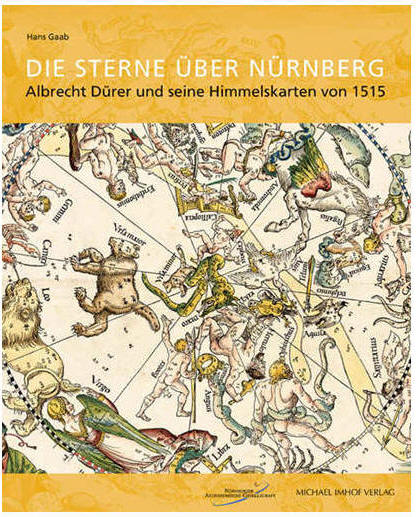
esamina nelle seguenti pagine le influenze delle tavole del Dürer sulla produzione cartografica celeste successiva
e le carte che hanno influito sulla sua produzione
Von Dürer beeinflusste Himmelskarten
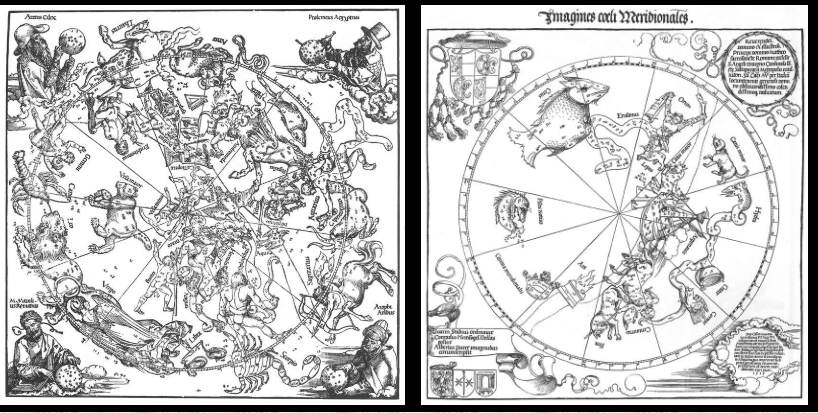
https://www.astronomie-nuernberg.de/index.php?category=duerer&page=sternkarten
https://www.astronomie-nuernberg.de/index.php?category=duerer&page=nachfolger
di FELICE STOPPA